
$-*."5&$)"/(&"%"15"5*0/'034."--)0-%&3
'"3.&34*/4065)"'3*$"
70-6.&1"35$-*."5&3&4*-*&/5"(3*$6-563&"/
*.1-&.&/5"5*0/"/%4611035(6*%&*/5&/4*7&)0.&45&"%
'00%130%6$5*0/13"$5*$&4
77

Climate Change Adaptation for
Smallholder Farmers in
South Africa
Volume 2 Part 2: Climate Resilient
Agriculture. An implementation and
support guide: Intensive homestead food
production practices
E Kruger, MC Dlamini, T Mathebula, P Ngcobo, BT Maimela & L Sisitka
Report to the
Water Research Commission
by
Mahlathini Development Foundation
Report No. TT 841/3/20
February 2021

ii
Obtainable from
Water Research Commission
Private Bag X03
Gezina, 0031
orders@wrc.org.za or download from www.wrc.org.za or www.mahlathini.org
The publication of this report emanates from a project entitled Collaborative knowledge creation and
mediation strategies for the dissemination of Water and Soil Conservation practices and Climate Smart
Agriculture in smallholder farming systems. (WRC Project No.K5/2719/4)
This report forms part of a series of 9 reports. The reports are:
Volume 1: Climate Change Adaptation for smallholder farmers in South Africa. An implementation
and decision support guide. Summary report. (WRC Report No. TT 841/1/20)
Volume 2 Part 1: Community Climate Change Adaptation facilitation: A manual for facilitation of
Climate Resilient Agriculture for smallholder farmers. (WRC Report No. TT 841/2/20)
Volume 2 Part 2: Climate Resilient Agriculture. An implementation and support guide: Intensive
homestead food production practices. (WRC Report No. TT 841/3/20)
Volume 2 Part 3: Climate Resilient Agriculture. An implementation and support guide: Local, group-
based access to water for household food production. (WRC Report No. TT 841/4/20)
Volume 2 Part 4: Climate Resilient Agriculture. An implementation and support guide: Field cropping
and livestock integration practices. (WRC Report No. TT 841/5/20)
Volume 2 Part 5: Climate Resilient Agriculture learning materials for smallholder farmers in English.
(WRC Report No. TT 841/6/20)
Volume 2 Part 6: Climate Resilient Agriculture learning materials for smallholder farmers in isiXhosa.
(WRC Report No. TT 841/7/20)
Volume 2 Part 7: Climate Resilient Agriculture learning materials for smallholder farmers in isiZulu.
(WRC Report No. TT 841/8/20)
Volume 2 Part 8: Climate Resilient Agriculture learning materials for smallholder farmers in Sepedi.
(WRC Report No. TT 841/9/20)
DISCLAIMER
This report has been reviewed by the Water Research Commission (WRC) and approved for
publication. Approval does not signify that the contents necessarily reflect the views and policies of
the WRC, nor does mention of trade names or commercial productsconstitute endorsement or
recommendation for use.
ISBN 978-0-6392-0229-7
Printed in the Republic of South Africa
© WATER RESEARCH COMMISSION
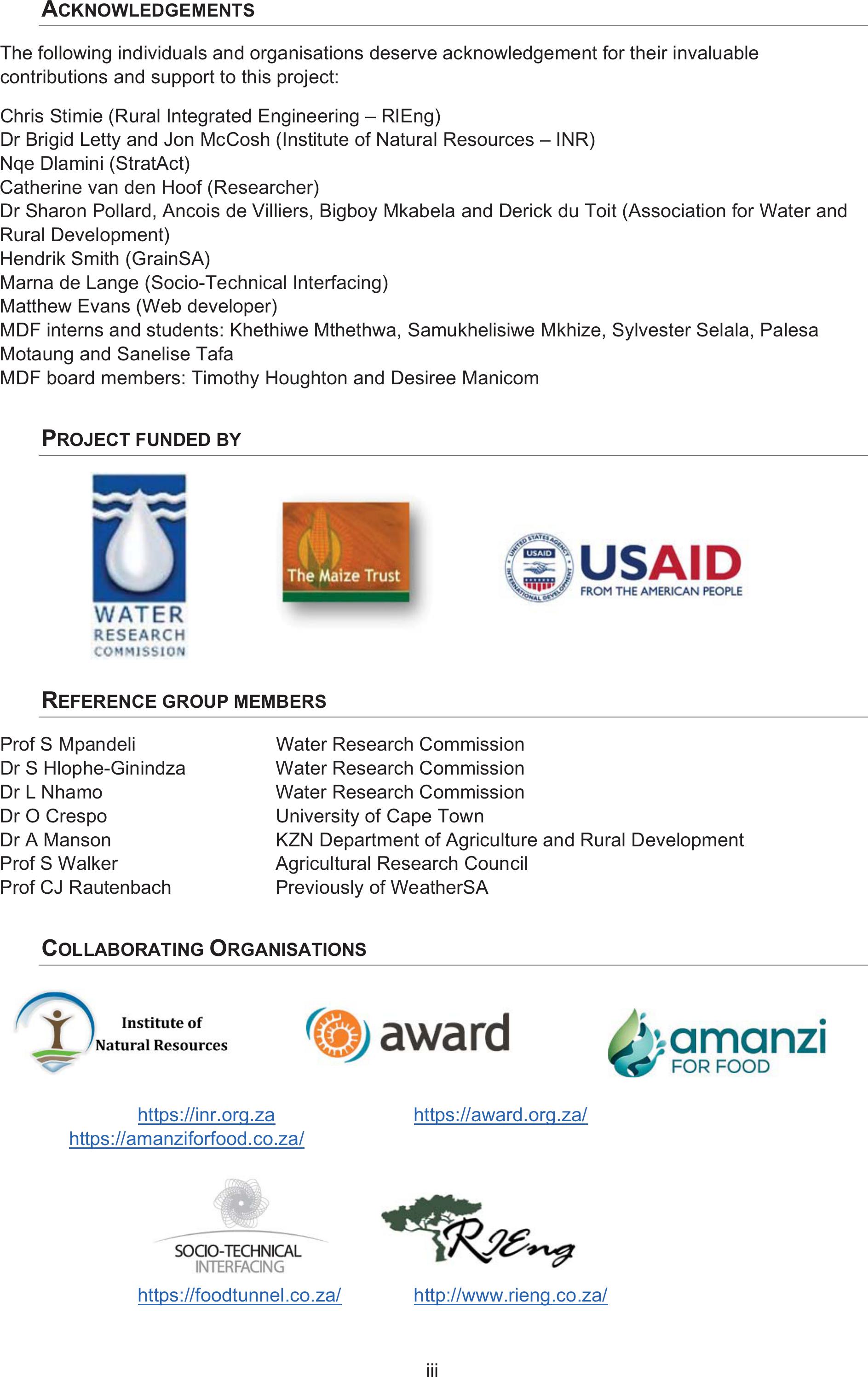
iii
ACKNOWLEDGEMENTS
The following individuals and organisations deserve acknowledgement for their invaluable
contributions and support to this project:
Chris Stimie (Rural Integrated Engineering – RIEng)
Dr Brigid Letty and Jon McCosh (Institute of Natural Resources – INR)
Nqe Dlamini (StratAct)
Catherine van den Hoof (Researcher)
Dr Sharon Pollard, Ancois de Villiers, Bigboy Mkabela and Derick du Toit (Association for Water and
Rural Development)
Hendrik Smith (GrainSA)
Marna de Lange (Socio-Technical Interfacing)
Matthew Evans (Web developer)
MDF interns and students: Khethiwe Mthethwa, Samukhelisiwe Mkhize, Sylvester Selala, Palesa
Motaung and Sanelise Tafa
MDF board members: Timothy Houghton and Desiree Manicom
PROJECT FUNDED BY
REFERENCE GROUP MEMBERS
Prof S Mpandeli Water Research Commission
Dr S Hlophe-Ginindza Water Research Commission
Dr L NhamoWater Research Commission
Dr O CrespoUniversity of Cape Town
Dr A Manson KZN Department of Agriculture and Rural Development
Prof S WalkerAgricultural Research Council
Prof CJ RautenbachPreviously of WeatherSA
COLLABORATING ORGANISATIONS
https://inr.org.zahttps://award.org.za/
https://amanziforfood.co.za/
https://foodtunnel.co.za/http://www.rieng.co.za/

iv
ABBREVIATIONS AND ACRONYMS
CA Conservation Agriculture
CC Climate change
CCA Climate change adaptation
CRA Climate resilient agriculture
EC Eastern Cape
KZN KwaZulu-Natal
MDF Mahlathini Development Foundation
SOC Soil organic carbon
SOM Soil organic matter
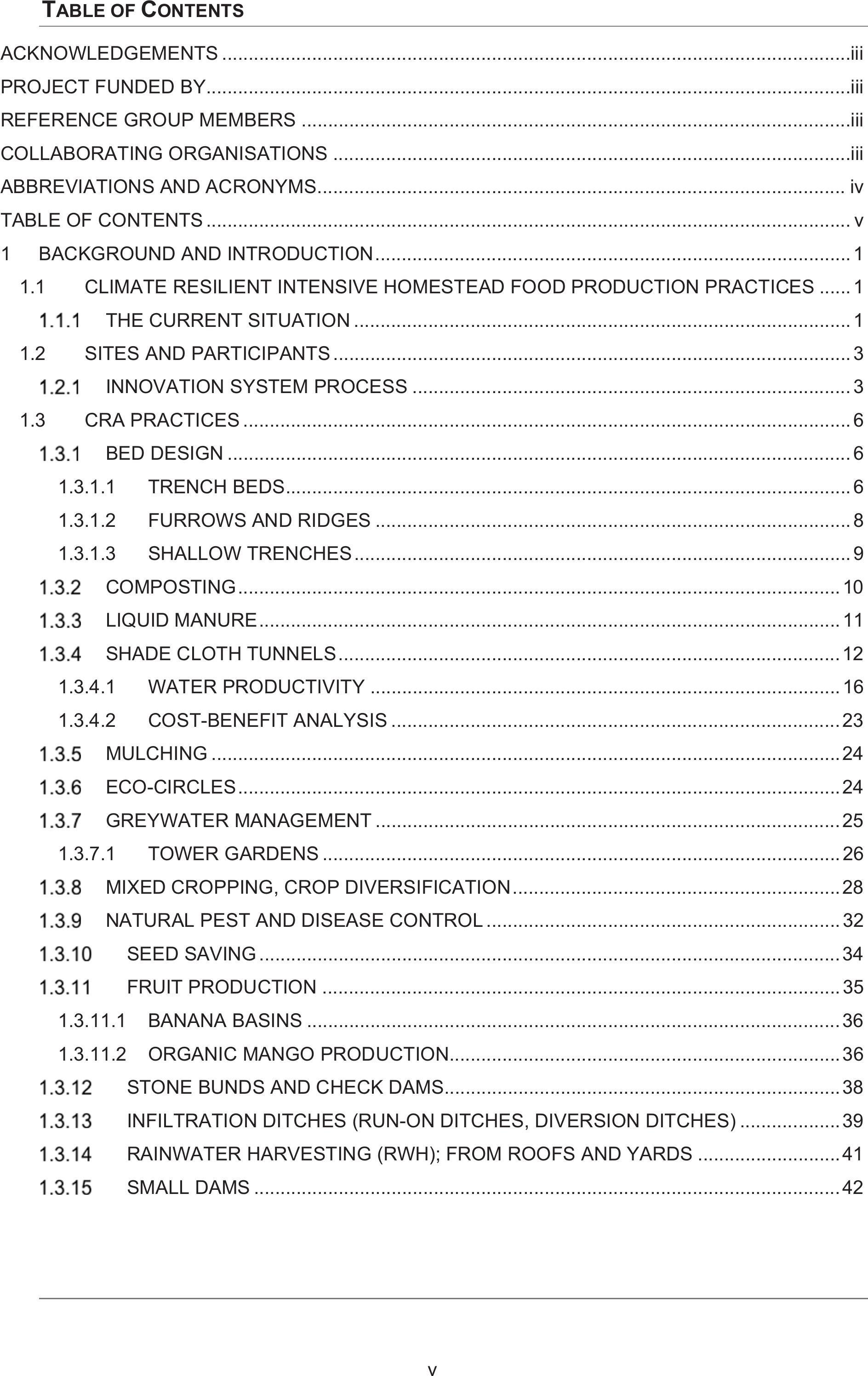
v
TABLE OF CONTENTS
ACKNOWLEDGEMENTS .......................................................................................................................iii
PROJECT FUNDED BY..........................................................................................................................iii
REFERENCE GROUP MEMBERS ........................................................................................................iii
COLLABORATING ORGANISATIONS ..................................................................................................iii
ABBREVIATIONS AND ACRONYMS .................................................................................................... iv
TABLE OF CONTENTS .......................................................................................................................... v
1BACKGROUND AND INTRODUCTION .......................................................................................... 1
1.1CLIMATE RESILIENT INTENSIVE HOMESTEAD FOOD PRODUCTION PRACTICES ...... 1
THE CURRENT SITUATION .............................................................................................. 1
1.2SITES AND PARTICIPANTS .................................................................................................. 3
INNOVATION SYSTEM PROCESS................................................................................... 3
1.3CRA PRACTICES ................................................................................................................... 6
BED DESIGN ...................................................................................................................... 6
1.3.1.1TRENCH BEDS........................................................................................................... 6
1.3.1.2FURROWS AND RIDGES .......................................................................................... 8
1.3.1.3SHALLOW TRENCHES.............................................................................................. 9
COMPOSTING .................................................................................................................. 10
LIQUID MANURE .............................................................................................................. 11
SHADE CLOTH TUNNELS ............................................................................................... 12
1.3.4.1WATER PRODUCTIVITY......................................................................................... 16
1.3.4.2COST-BENEFIT ANALYSIS..................................................................................... 23
MULCHING ....................................................................................................................... 24
ECO-CIRCLES .................................................................................................................. 24
GREYWATER MANAGEMENT........................................................................................ 25
1.3.7.1TOWER GARDENS .................................................................................................. 26
MIXED CROPPING, CROP DIVERSIFICATION.............................................................. 28
NATURAL PEST AND DISEASE CONTROL ................................................................... 32
SEED SAVING .............................................................................................................. 34
FRUIT PRODUCTION .................................................................................................. 35
1.3.11.1BANANA BASINS ..................................................................................................... 36
1.3.11.2ORGANIC MANGO PRODUCTION .......................................................................... 36
STONE BUNDS AND CHECK DAMS........................................................................... 38
INFILTRATION DITCHES (RUN-ON DITCHES, DIVERSION DITCHES) ................... 39
RAINWATER HARVESTING (RWH); FROM ROOFS AND YARDS ........................... 41
SMALL DAMS............................................................................................................... 42
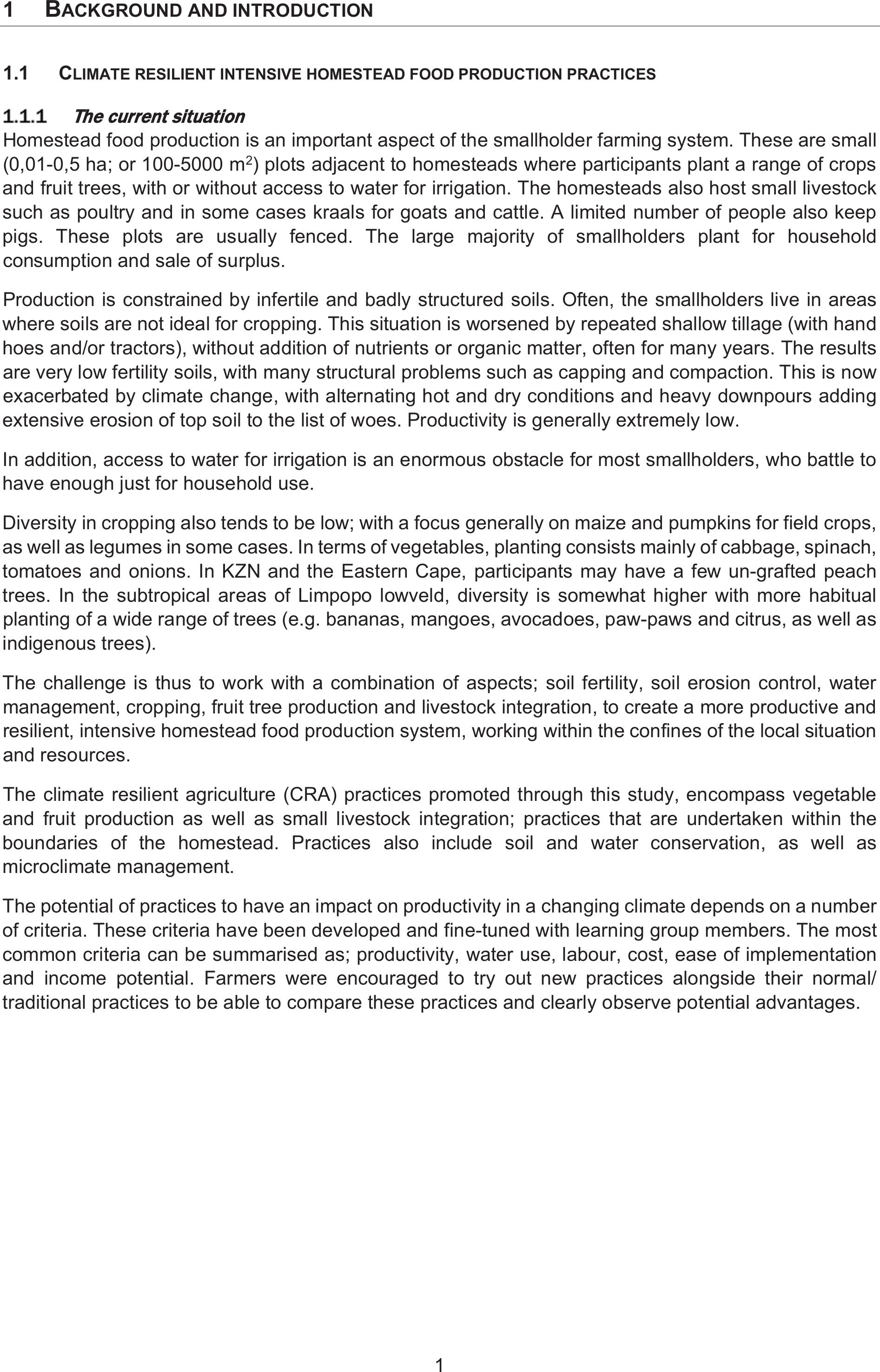
1
1 BACKGROUND AND INTRODUCTION
1.1 CLIMATE RESILIENT INTENSIVE HOMESTEAD FOOD PRODUCTION PRACTICES
T
The current situation
Homestead food production is an important aspect of the smallholder farming system. These are small
(0,01-0,5 ha; or 100-5000 m2) plots adjacent to homesteads where participants plant a range of crops
and fruit trees, with or without access to water for irrigation. The homesteads also host small livestock
such as poultry and in some cases kraals for goats and cattle. A limited number of people also keep
pigs. These plots are usually fenced. The large majority of smallholders plant for household
consumption and sale of surplus.
Production is constrained by infertile and badly structured soils. Often, the smallholders live in areas
where soils are not ideal for cropping. This situation is worsened by repeated shallow tillage (with hand
hoes and/or tractors), without addition of nutrients or organic matter, often for many years. The results
are very low fertility soils, with many structural problems such as capping and compaction. This is now
exacerbated by climate change, with alternating hot and dry conditions and heavy downpours adding
extensive erosion of top soil to the list of woes. Productivity is generally extremely low.
In addition, access to water for irrigation is an enormous obstacle for most smallholders, who battle to
have enough just for household use.
Diversity in cropping also tends to be low; with a focus generally on maize and pumpkins for field crops,
as well as legumes in some cases. In terms of vegetables, planting consists mainly of cabbage, spinach,
tomatoes and onions. In KZN and the Eastern Cape, participants may have a few un-grafted peach
trees. In the subtropical areas of Limpopo lowveld, diversity is somewhat higher with more habitual
planting of a wide range of trees (e.g. bananas, mangoes, avocadoes, paw-paws and citrus, as well as
indigenous trees).
The challenge is thus to work with a combination of aspects; soil fertility, soil erosion control, water
management, cropping, fruit tree production and livestock integration, to create a more productive and
resilient, intensive homestead food production system, working within the confines of the local situation
and resources.
The climate resilient agriculture (CRA) practices promoted through this study, encompass vegetable
and fruit production as well as small livestock integration; practices that are undertaken within the
boundaries of the homestead. Practices also include soil and water conservation, as well as
microclimate management.
The potential of practices to have an impact on productivity in a changing climate depends on a number
of criteria. These criteria have been developed and fine-tuned with learning group members. The most
common criteria can be summarised as; productivity, water use, labour, cost, ease of implementation
and income potential. Farmers were encouraged to try out new practices alongside their normal/
traditional practices to be able to compare these practices and clearly observe potential advantages.

2
Comments from farmers about the overall process:
¾“Leaving the soil exposed to heat and rain and turning over the soil to plough and plant has
destroyed the soil, making it infertile and very hard. Improving the soil takes time, but makes a
big difference in growth of crops.”
¾“I have learnt about practices that will help me continue with farming activitieseven though
water is a struggle and the sun is too hot for any vegetable to survive in our environment. The
little we have been given is better than nothing.”
¾“Climate change has been hard on us, especially on our farming activities. Farming seems
impossible in this condition, especially with no rain. Being unemployed and relying on grants is
even worse, as the head of the household; farming makes it better because you farm for both
consumption and making an income.”
¾“I have experienced harsh weather with no rain and no harvests using our traditional ways of
farming, which affected our livelihood as we had to buy all vegetables instead of growing them
myself. Now I know how to deal with changes of climate, since I met Mahlathini and AWARD
and they taught us practices that changed my life. I don’t buy vegetables that I need every day,
I pick from my garden.”
¾“It’s not easy to implement new things, but if results are presented and examples are shown to
prove that the practice is being tried by other farmers and it’s working very well, then it makes
it easier for us to try.”
¾“It’s not easy to move from traditional ways of doing things to something new, because we
sometimes associate change with risk that we are not ready for.”
¾“Seeing results from other people’s gardens motivates us to try these ideas ourselves.”
¾“We progress much faster when we work together in learning groups, discuss issues and visit
each other’s gardens.”
This document provides a description of different CRA practices tried out by smallholder farmers in their
learning groups, some examples of implementation, comments from farmers, assessment of impact
and an overall rating based on farmers’ views and in some cases, measurements.
Rating
As a means of providing a quick qualitative and visual summary of the impact of each CRA practice on
the resilience of the smallholder farming system, a rating has been devised as follows:
Criteria Descriptors Score (1 point for
each descriptor)
Improved food provisionMore food, increased diversity, increased continuity 3
Improved soil conditions Improved fertility, improved organic matter, improved
soil health
3
Improved water
management
Improved water holding capacity, efficient use of water,
improved access
3
Uptake of practice Experimentation with practice (no of people),
continuation of practice after experimentation,
increased implementation of practice
3
Skills and resources to
sustain practice
Use of own resources, knowledge to implement practice
adequately, access to required/external resources
3
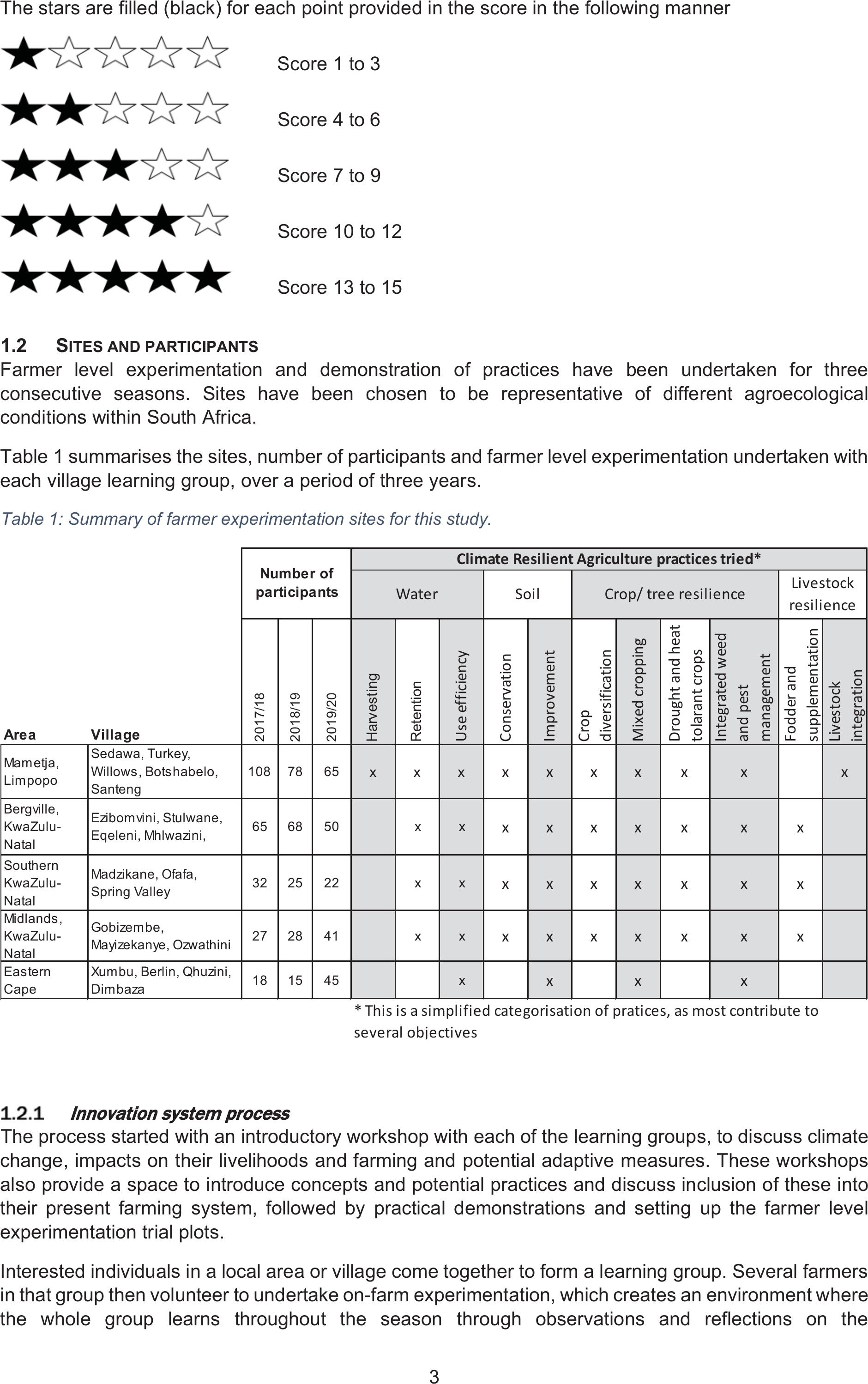
3
The stars are filled (black) for each point provided in the score in the following manner
Score 1 to 3
Score 4 to 6
Score 7 to 9
Score 10 to 12
Score 13 to 15
1.2 SITES AND PARTICIPANTS
Farmer level experimentation and demonstration of practices have been undertaken for three
consecutive seasons. Sites have been chosen to be representative of different agroecological
conditions within South Africa.
Table 1 summarises the sites, number of participants and farmer level experimentation undertaken with
each village learning group, over a period of three years.
Table 1: Summary of farmer experimentation sites for this study.
I
Innovation system process
The process started with an introductory workshop with each of the learning groups, to discuss climate
change, impacts on their livelihoods and farming and potential adaptive measures. These workshops
also provide a space to introduce concepts and potential practices and discuss inclusion of these into
their present farming system, followed by practical demonstrations and setting up the farmer level
experimentation trial plots.
Interested individuals in a local area or village come together to form a learning group. Several farmers
in that group then volunteer to undertake on-farm experimentation, which creates an environment where
the whole group learns throughout the season through observations and reflections on the
2017/18
2018/19
2019/20
Harvesting
Retention
Use efficiency
Conservation
Improvement
Crop
diversification
Mixed cropping
Drought and heat
tolarant crops
Integrated weed
and pest
management
Fodder and
supplementation
Livestock
integration
Mam etja,
Limpopo
Sedawa, Turkey,
Willows, Botshabelo,
Santeng
108 7865
xxx
xxxx xxx
Bergville,
KwaZulu-
Natal
Ezibomvini, Stulwane,
Eqeleni, Mhlwazini,65 6850xx
xxxx xxx
Southern
KwaZulu-
Natal
Madzikane, Ofafa,
Spring Valley32 2522xx
xxxx xxx
Midlands,
KwaZulu-
Natal
Gobizembe,
Mayizekanye, Ozwathini27 2841xx
xxxx xxx
Eastern
Cape
Xumbu, Berlin, Qhuzini,
Dimbaza 18 1545x
xx x
VillageArea
* This is a simplified categorisation of pratices, as most contribute to
several ob
j
ectives
Livestock
resilience
Number of
participants
WaterSoilCrop/ tree resilience
Climate Resilient Agriculture practices tried*

4
implementation and results of the chosen trials. Farmers compare various treatments with their standard
practices, which are planted as control plots.
The group assesses and reviews the CRA practices each season and, based on their observations and
learning, make decisions regarding the next season’s implementation and experimentation. In this way
the farming system is continually improved and adapted.
The table below outlines the practices introduced that farmers chose to experiment with and include in
into their farming system. It also gives a summary of the rating for each practice.
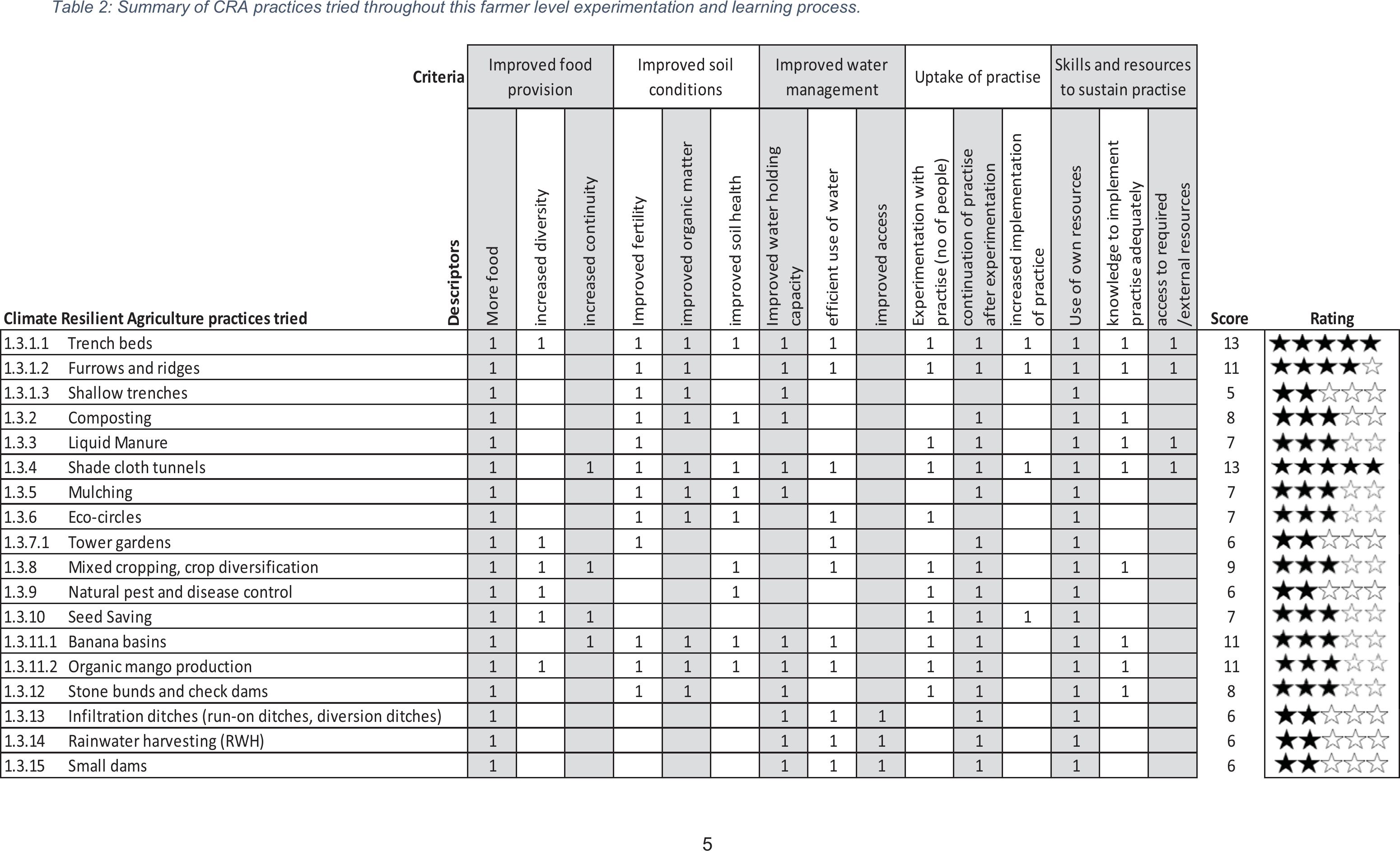
5
Table 2: Summary of CRA practices tried throughout this farmer level experimentation and learning process.
Descriptors
More food
increased diversity
increased continuity
Improved fertility
improved organic matter
improved soil health
Improved water holding
capacity
efficient use of water
improved access
Experimentation with
practise (no of people)
continuation of practise
after experimentation
increased implementation
of practice
Use of own resources
knowledge to implement
practise adequately
access to required
/external resources
Score Rating
1.3.1.1Trench beds111111111111113
1.3.1.2Furrows and ridges1111111111111
1.3.1.3Shallow trenches111115
1.3.2Composting11 1 1 111 18
1.3.3Liquid Manure11111117
1.3.4Shade cloth tunnels1111111111111 13
1.3.5Mulching11 1 1 1117
1.3.6Eco-circles1 11111 17
1.3.7.1Tower gardens1111116
1.3.8Mixed cropping, crop diversification1111111119
1.3.9Natural pest and disease control1111116
1.3.10Seed Saving11111117
1.3.11.1Banana basins1111111111111
1.3.11.2Organic mango production1111111111111
1.3.12Stone bunds and check dams111111118
1.3.13Infiltration ditches (run-on ditches, diversion ditches)1111116
1.3.14Rainwater harvesting (RWH)1111116
1.3.15Small dams1111116
Climate Resilient Agriculture practices tried
Criteria Skills and resources
to sustain practise
Improved food
provision
Improved soil
conditions
Improved water
management Uptake of practise
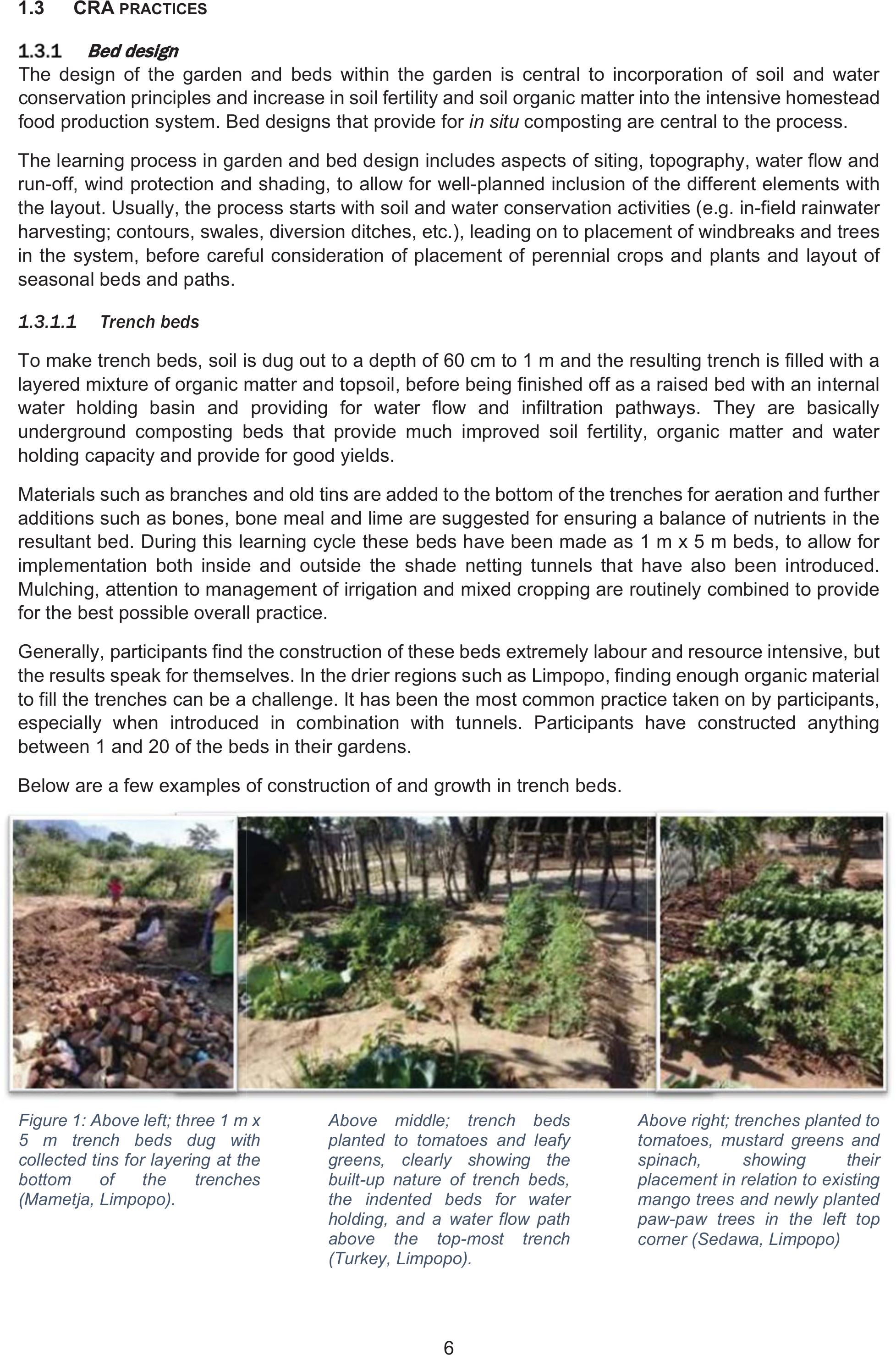
6
1.3 CRA PRACTICES
B
Bed design
The design of the garden and beds within the garden is central to incorporation of soil and water
conservation principles and increase in soil fertility and soil organic matter into the intensive homestead
food production system. Bed designs that provide for in situ composting are central to the process.
The learning process in garden and bed design includes aspects of siting, topography, water flow and
run-off, wind protection and shading, to allow for well-planned inclusion of the different elements with
the layout. Usually, the process starts with soil and water conservation activities (e.g. in-field rainwater
harvesting; contours, swales, diversion ditches, etc.), leading on to placement of windbreaks and trees
in the system, before careful consideration of placement of perennial crops and plants and layout of
seasonal beds and paths.
1.3.1.1Trench beds
To make trench beds, soil is dug out to a depth of 60 cm to 1 m and the resulting trench is filled with a
layered mixture of organic matter and topsoil, before being finished off as a raised bed with an internal
water holding basin and providing for water flow and infiltration pathways. They are basically
underground composting beds that provide much improved soil fertility, organic matter and water
holding capacity and provide for good yields.
Materials such as branches and old tins are added to the bottom of the trenches for aeration and further
additions such as bones, bone meal and lime are suggested for ensuring a balance of nutrients in the
resultant bed. During this learning cycle these beds have been made as 1 m x 5 m beds, to allow for
implementation both inside and outside the shade netting tunnels that have also been introduced.
Mulching, attention to management of irrigation and mixed cropping are routinely combined to provide
for the best possible overall practice.
Generally, participants find the construction of these beds extremely labour and resource intensive, but
the results speak for themselves. In the drier regions such as Limpopo, finding enough organic material
to fill the trenches can be a challenge. It has been the most common practice taken on by participants,
especially when introduced in combination with tunnels. Participants have constructed anything
between 1 and 20 of the beds in their gardens.
Below are a few examples of construction of and growth in trench beds.
Figure 1: Above left; three 1 m x
5 m trench beds dug with
collected tins for layering at the
bottom of the trenches
(Mametja, Limpopo).
Above middle; trench beds
planted to tomatoes and leafy
greens, clearly showing the
built-up nature of trench beds,
the indented beds for water
holding, and a water flow path
above the top-most trench
(Turkey, Limpopo).
Above right; trenches planted to
tomatoes, mustard greens and
spinach, showing their
placement in relation to existing
mango trees and newly planted
paw-paw trees in the left top
corner (Sedawa, Limpopo)
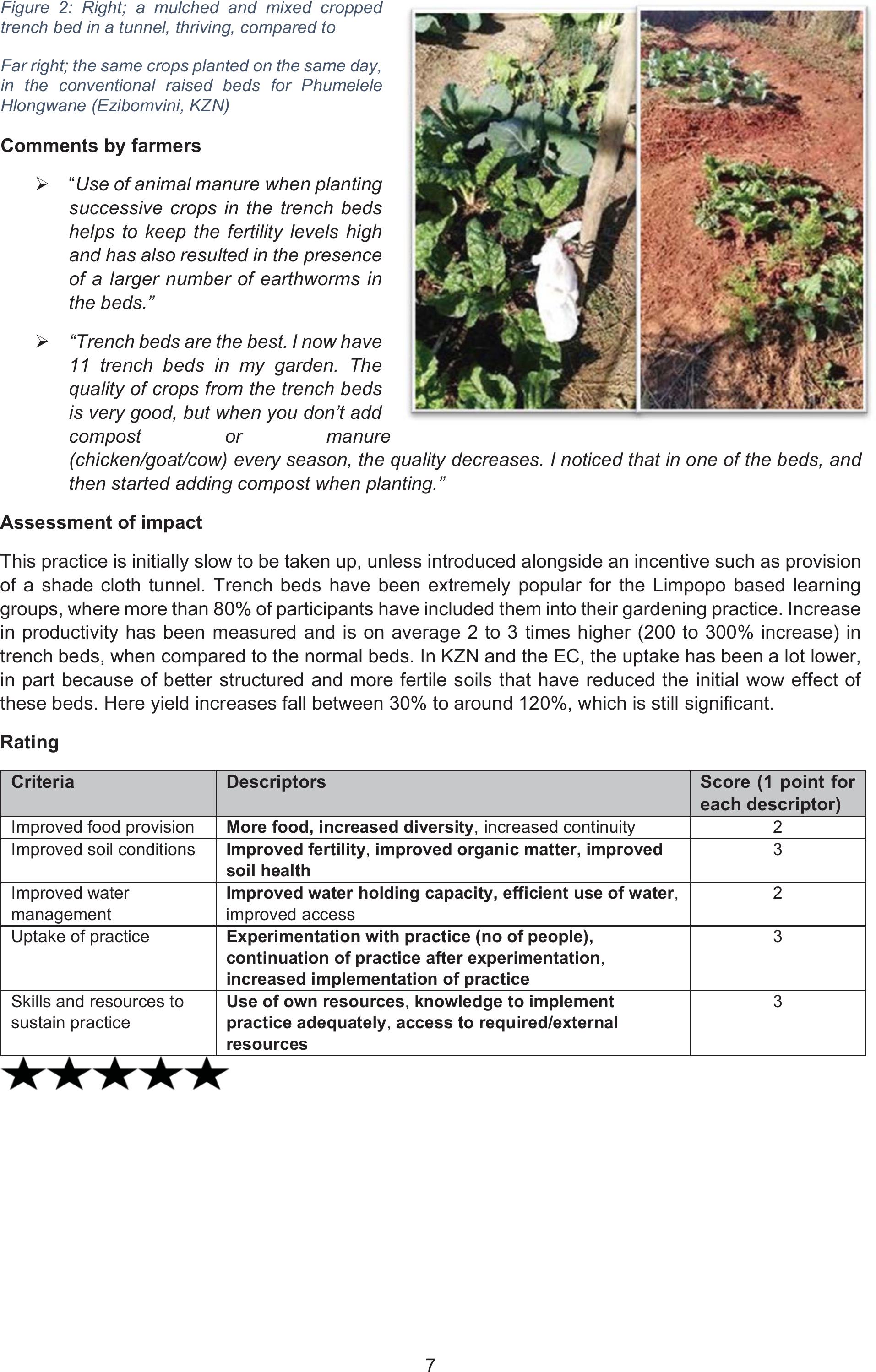
7
Figure 2: Right; a mulched and mixed cropped
trench bed in a tunnel, thriving, compared to
Far right; the same crops planted on the same day,
in the conventional raised beds for Phumelele
Hlongwane (Ezibomvini, KZN)
Comments by farmers
¾ “Use of animal manure when planting
successive crops in the trench beds
helps to keep the fertility levels high
and has also resulted in the presence
of a larger number of earthworms in
the beds.”
¾“Trench beds are the best. I now have
11 trench beds in my garden. The
quality of crops from the trench beds
is very good, but when you don’t add
compost or manure
(chicken/goat/cow) every season, the quality decreases. I noticed that in one of the beds, and
then started adding compost when planting.”
Assessment of impact
This practice is initially slow to be taken up, unless introduced alongside an incentive such as provision
of a shade cloth tunnel. Trench beds have been extremely popular for the Limpopo based learning
groups, where more than 80% of participants have included them into their gardening practice. Increase
in productivity has been measured and is on average 2 to 3 times higher (200 to 300% increase) in
trench beds, when compared to the normal beds. In KZN and the EC, the uptake has been a lot lower,
in part because of better structured and more fertile soils that have reduced the initial wow effect of
these beds. Here yield increases fall between 30% to around 120%, which is still significant.
Rating
Criteria Descriptors Score (1 point for
each descriptor)
Improved food provisionMore food, increased diversity, increased continuity2
Improved soil conditions Improved fertility, improved organic matter, improved
soil health
3
Improved water
management
Improved water holding capacity, efficient use of water,
improved access
2
Uptake of practice Experimentation with practice (no of people),
continuation of practice after experimentation,
increased implementation of practice
3
Skills and resources to
sustain practice
Use of own resources, knowledge to implement
practice adequately, access to required/external
resources
3

8
1.3.1.2Furrows and ridges
A traditional planting practice, furrows and ridges are used extensively in parts of Mpumalanga and
Limpopo, where soil is ridged and crops are planted on the ridges. The furrows serve to lead water
(irrigation and/or rain) to the crops. Adaptations made to this practice to improve on this design is the
inclusion of organic matter (manure, weeds, compost, crop residues) into the ridges, mulching and
placing these ridges on contour, to improve water flow to the beds and reduce the erosion potential.
The practice is particularly useful for growing sweet potatoes, but a range of crops can be grown. The
effect is very similar to shallow trenches and can be used at any scale. Integrated into the garden design
it also allows for channelling water and allowing for slow seepage into the surrounding beds for
improved water management.
Below are a few examples.
Figure 3: Above left; A furrow
and ridge meandering on a
contour, planted to sweet potato
and mulched, using maize
residues, banana stems and
tree leaves. In this case the
furrow is also providing extra
water infiltration for the mango
trees in this garden. Above
centre; Furrows and ridges
planted to tomatoes, carrots,
maize and spinach. The water
flow paths are clearly visible, as
is a trench bed under
construction on the right-hand
side of the picture.
Above right; Furrows and ridges
mulched with dry grass and
planted to tomatoes. Flood
irrigation is practiced, using the
black irrigation piping seen in
the foreground of the picture
(Sedawa, Limpopo).
Comments by farmers
¾“Using manure and mulching in our traditional beds, the furrows and ridges, has helped to
increase crop survival and yields.”
Assessment of impact
This practice is already widespread in Limpopo and introduction of the improvements to the system has
been easy. It is much simpler for participants to improve on something they are already doing, than
starting on a new practice. The practice is best suited to the conditions and soil types in Limpopo and
the EC, but has not been introduced in KZN. Sandy-clay, low fertility soils with a tendency towards
capping work well, while soils with a high proportion of loam and clay tend to become very hard and the
ridges dry out fast and are difficult to re-wet. The capping of the sandier soils tends to ‘lock’ the moisture
into the soil without reducing aeration – which the heavier clay soils do not. Generally, the water
productivity (WP) of furrows and ridges is much lower than trench beds. Calculations have shown a
150% to 300% increase in water productivity for the trenches when compared to furrows and ridges,
where increased fertility and mulching are not used, and an 80% to 160% increase in WP where they
are.

9
Rating
Criteria Descriptors Score (1 point for
each descriptor)
Improved food provision More food, increased diversity, increased continuity 1
Improved soil conditions Improved fertility, improved organic matter, improved
soil health
2
Improved water
management
Improved water holding capacity, efficient use of water,
improved access
2
Uptake of practice Experimentation with practice, (no of people),
continuation of practice after experimentation,
increased implementation of practice
3
Skills and resources to
sustain practice
Use of own resources, knowledge to implement
practice adequately, access to required/external
resources
3
1.3.1.3Shallow trenches
The shallow trench is a variation on trench beds that can also be implemented at a larger scale, where
a ditch 15 cm deep and 30 cm wide is constructed on contour and is then filled with organic matter;
usually manure, grass and crop residues, and the top soil is replaced on top of this mixture. Crops are
planted either in the sides of the ridge formed or on top.
Shallow trenches are much easier to construct than deep trenches, but the fertility does not last as long
and thus these beds are re-constructed
every 2nd to 3rd season. It is recommended
that legumes are planted initially, as in the
beginning stages Nitrogen can be a bit
limiting for these beds.
Alongside are a few examples.
Figure 4: Right; digging a shallow trench in a
homestead field cropping plot (Turkey Limpopo)
and Far right; the beginnings of filling in a shallow
trench (Mametja, Limpopo)
Assessment of impact
Although the practice is comparatively low
in labour and resource requirements and is particularly good in terms of rehabilitating low fertility capped
soils, participants have been slow in taking on this practice; partly due to deeply entrenched habitual
practices, and partly due to the slow initial increase in fertility and crop growth.
Rating
Criteria Descriptors Score (1 point for
each descriptor)
Improved food provision More food, increased diversity, increased continuity 1
Improved soil conditions Improved fertility, improved organic matter, improved
soil health
2
Improved water
management
Improved water holding capacity, efficient use of water,
improved access
1
Uptake of practice Experimentation with practice (no of people), continuation
of practice after experimentation, increased implementation
of practice
0
Skills and resources to
sustain practice
Use of own resources, knowledge to implement practice
adequately,access to required/external resources
1
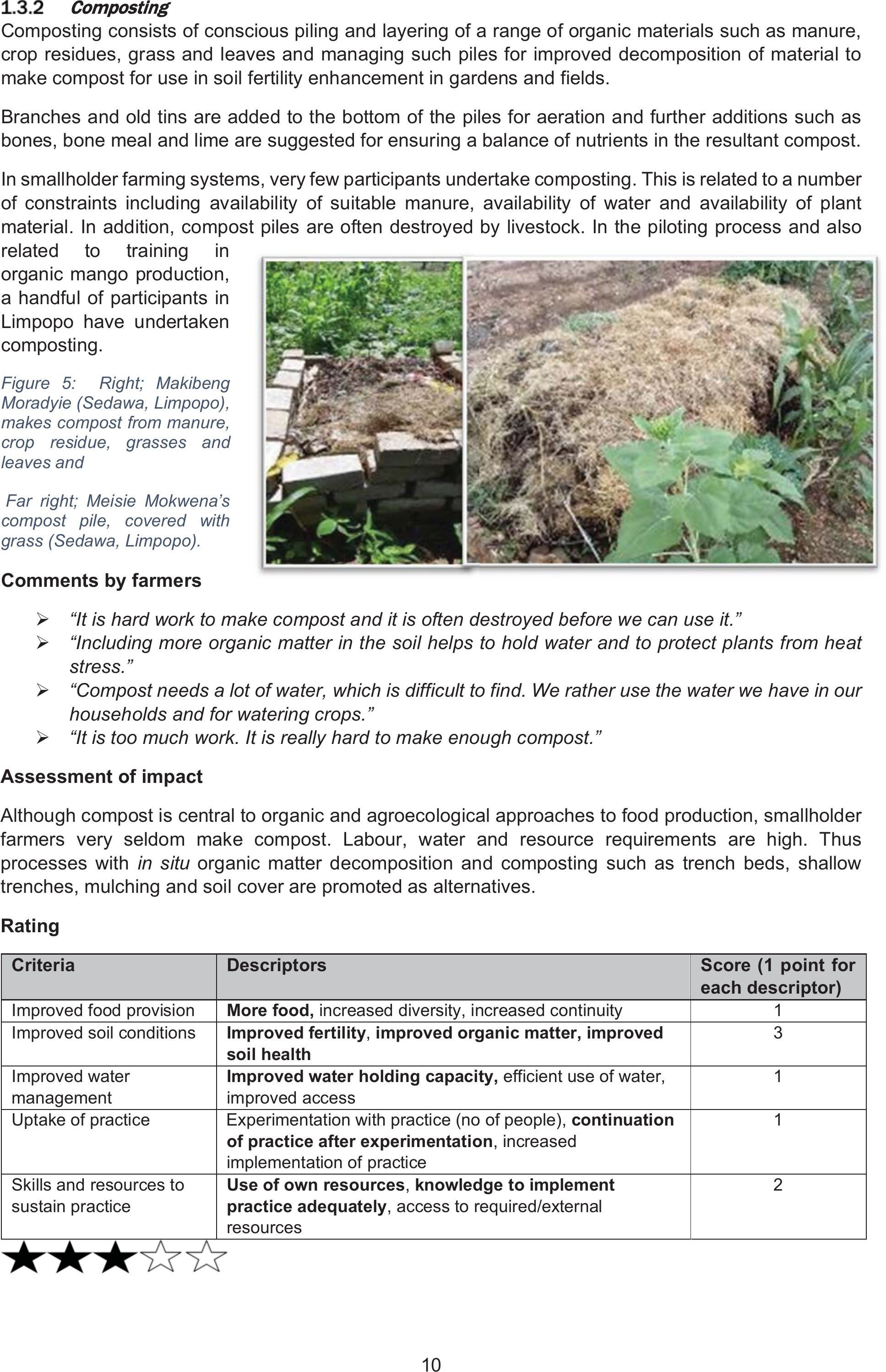
10
C
Composting
Composting consists of conscious piling and layering of a range of organic materials such as manure,
crop residues, grass and leaves and managing such piles for improved decomposition of material to
make compost for use in soil fertility enhancement in gardens and fields.
Branches and old tins are added to the bottom of the piles for aeration and further additions such as
bones, bone meal and lime are suggested for ensuring a balance of nutrients in the resultant compost.
In smallholder farming systems, very few participants undertake composting. This is related to a number
of constraints including availability of suitable manure, availability of water and availability of plant
material. In addition, compost piles are often destroyed by livestock. In the piloting process and also
related to training in
organic mango production,
a handful of participants in
Limpopo have undertaken
composting.
Figure 5: Right; Makibeng
Moradyie (Sedawa, Limpopo),
makes compost from manure,
crop residue, grasses and
leaves and
Far right; Meisie Mokwena’s
compost pile, covered with
grass (Sedawa, Limpopo).
Comments by farmers
¾“It is hard work to make compost and it is often destroyed before we can use it.”
¾“Including more organic matter in the soil helps to hold water and to protect plants from heat
stress.”
¾“Compost needs a lot of water, which is difficult to find. We rather use the water we have in our
households and for watering crops.”
¾“It is too much work. It is really hard to make enough compost.”
Assessment of impact
Although compost is central to organic and agroecological approaches to food production, smallholder
farmers very seldom make compost. Labour, water and resource requirements are high. Thus
processes with in situ organic matter decomposition and composting such as trench beds, shallow
trenches, mulching and soil cover are promoted as alternatives.
Rating
Criteria Descriptors Score (1 point for
each descriptor)
Improved food provision More food, increased diversity, increased continuity 1
Improved soil conditions Improved fertility, improved organic matter, improved
soil health
3
Improved water
management
Improved water holding capacity, efficient use of water,
improved access
1
Uptake of practice Experimentation with practice (no of people), continuation
of practice after experimentation, increased
implementation of practice
1
Skills and resources to
sustain practice
Use of own resources, knowledge to implement
practice adequately, access to required/external
resources
2
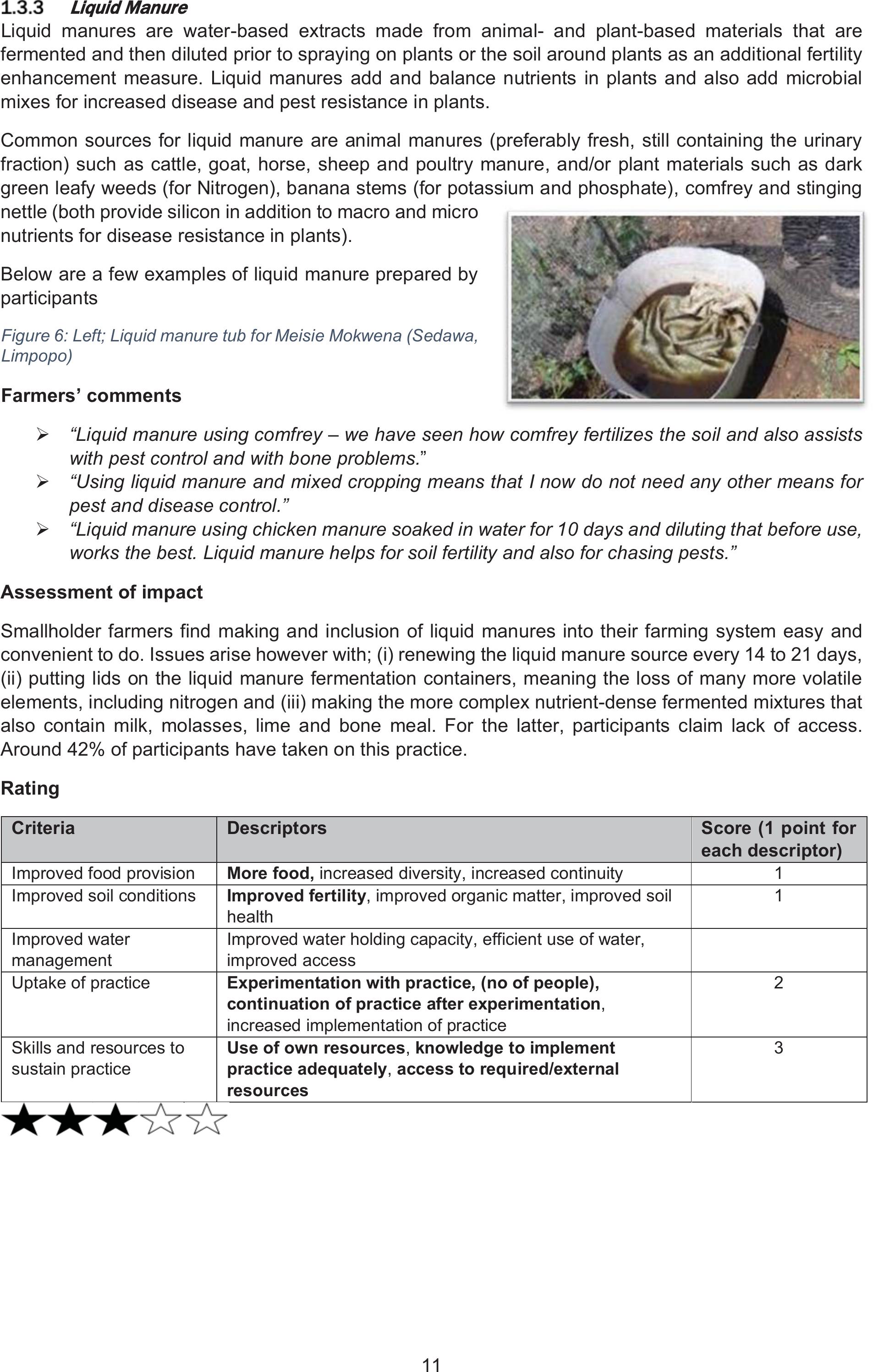
11
L
Liquid Manure
Liquid manures are water-based extracts made from animal- and plant-based materials that are
fermented and then diluted prior to spraying on plants or the soil around plants as an additional fertility
enhancement measure. Liquid manures add and balance nutrients in plants and also add microbial
mixes for increased disease and pest resistance in plants.
Common sources for liquid manure are animal manures (preferably fresh, still containing the urinary
fraction) such as cattle, goat, horse, sheep and poultry manure, and/or plant materials such as dark
green leafy weeds (for Nitrogen), banana stems (for potassium and phosphate), comfrey and stinging
nettle (both provide silicon in addition to macro and micro
nutrients for disease resistance in plants).
Below are a few examples of liquid manure prepared by
participants
Figure 6: Left; Liquid manure tub for Meisie Mokwena (Sedawa,
Limpopo)
Farmers’ comments
¾“Liquid manure using comfrey – we have seen how comfrey fertilizes the soil and also assists
with pest control and with bone problems.”
¾“Using liquid manure and mixed cropping means that I now do not need any other means for
pest and disease control.”
¾“Liquid manure using chicken manure soaked in water for 10 days and diluting that before use,
works the best. Liquid manure helps for soil fertility and also for chasing pests.”
Assessment of impact
Smallholder farmers find making and inclusion of liquid manures into their farming system easy and
convenient to do. Issues arise however with; (i) renewing the liquid manure source every 14 to 21 days,
(ii) putting lids on the liquid manure fermentation containers, meaning the loss of many more volatile
elements, including nitrogen and (iii) making the more complex nutrient-dense fermented mixtures that
also contain milk, molasses, lime and bone meal. For the latter, participants claim lack of access.
Around 42% of participants have taken on this practice.
Rating
Criteria Descriptors Score (1 point for
each descriptor)
Improved food provision More food, increased diversity, increased continuity 1
Improved soil conditions Improved fertility, improved organic matter, improved soil
health
1
Improved water
management
Improved water holding capacity, efficient use of water,
improved access
Uptake of practice Experimentation with practice, (no of people),
continuation of practice after experimentation,
increased implementation of practice
2
Skills and resources to
sustain practice
Use of own resources, knowledge to implement
practice adequately, access to required/external
resources
3
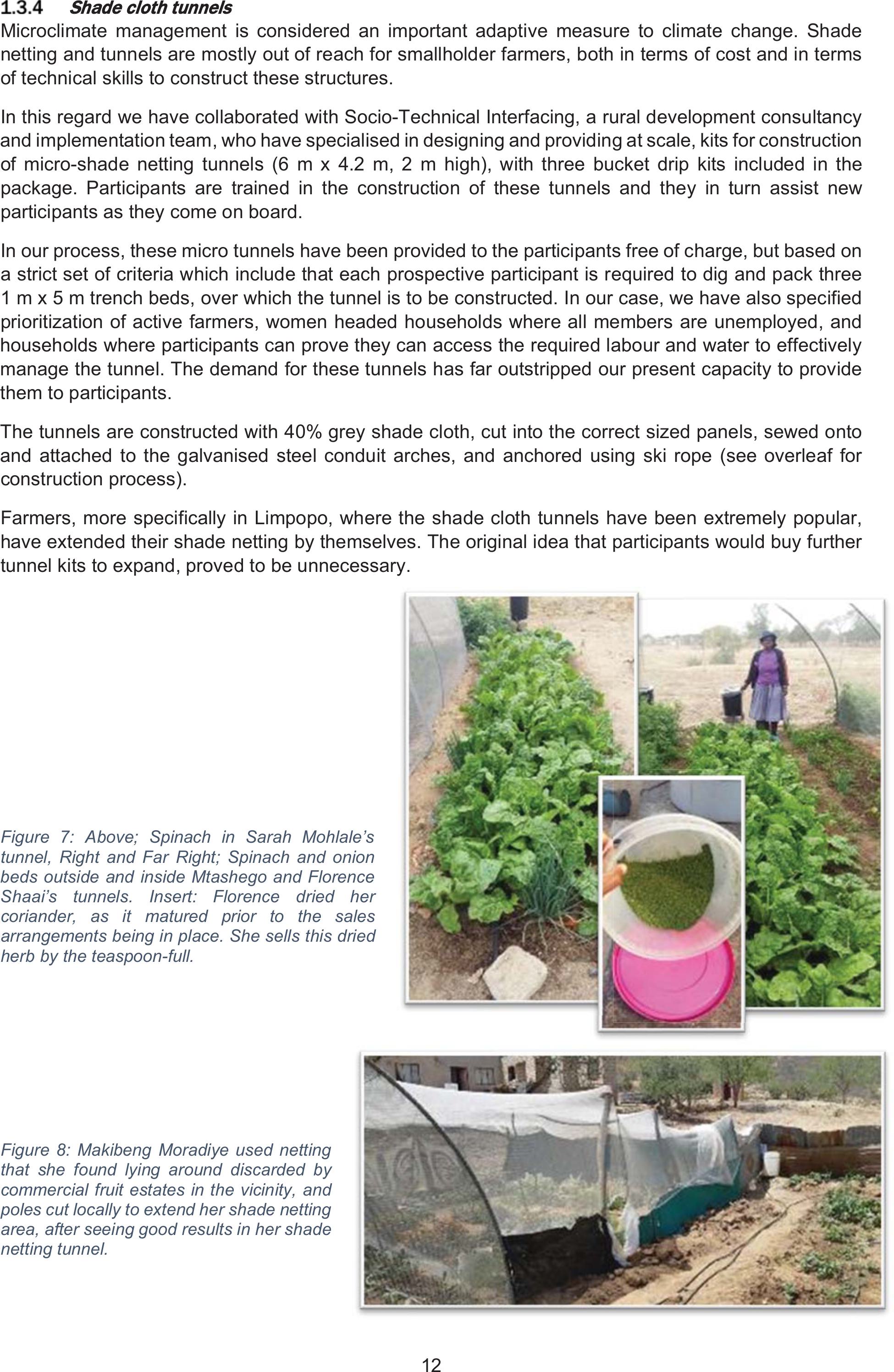
12
S
Shade cloth tunnels
Microclimate management is considered an important adaptive measure to climate change. Shade
netting and tunnels are mostly out of reach for smallholder farmers, both in terms of cost and in terms
of technical skills to construct these structures.
In this regard we have collaborated with Socio-Technical Interfacing, a rural development consultancy
and implementation team, who have specialised in designing and providing at scale, kits for construction
of micro-shade netting tunnels (6 m x 4.2 m, 2 m high), with three bucket drip kits included in the
package. Participants are trained in the construction of these tunnels and they in turn assist new
participants as they come on board.
In our process, these micro tunnels have been provided to the participants free of charge, but based on
a strict set of criteria which include that each prospective participant is required to dig and pack three
1 m x 5 m trench beds, over which the tunnel is to be constructed. In our case, we have also specified
prioritization of active farmers, women headed households where all members are unemployed, and
households where participants can prove they can access the required labour and water to effectively
manage the tunnel. The demand for these tunnels has far outstripped our present capacity to provide
them to participants.
The tunnels are constructed with 40% grey shade cloth, cut into the correct sized panels, sewed onto
and attached to the galvanised steel conduit arches, and anchored using ski rope (see overleaf for
construction process).
Farmers, more specifically in Limpopo, where the shade cloth tunnels have been extremely popular,
have extended their shade netting by themselves. The original idea that participants would buy further
tunnel kits to expand, proved to be unnecessary.
Figure 7:Above; Spinach in Sarah Mohlale’s
tunnel, Right and Far Right; Spinach and onion
beds outside and inside Mtashego and Florence
Shaai’s tunnels. Insert: Florence dried her
coriander, as it matured prior to the sales
arrangements being in place. She sells this dried
herb by the teaspoon-full.
Figure 8: Makibeng Moradiye used netting
that she found lying around discarded by
commercial fruit estates in the vicinity, and
poles cut locally to extend her shade netting
area, after seeing good results in her shade
netting tunnel.
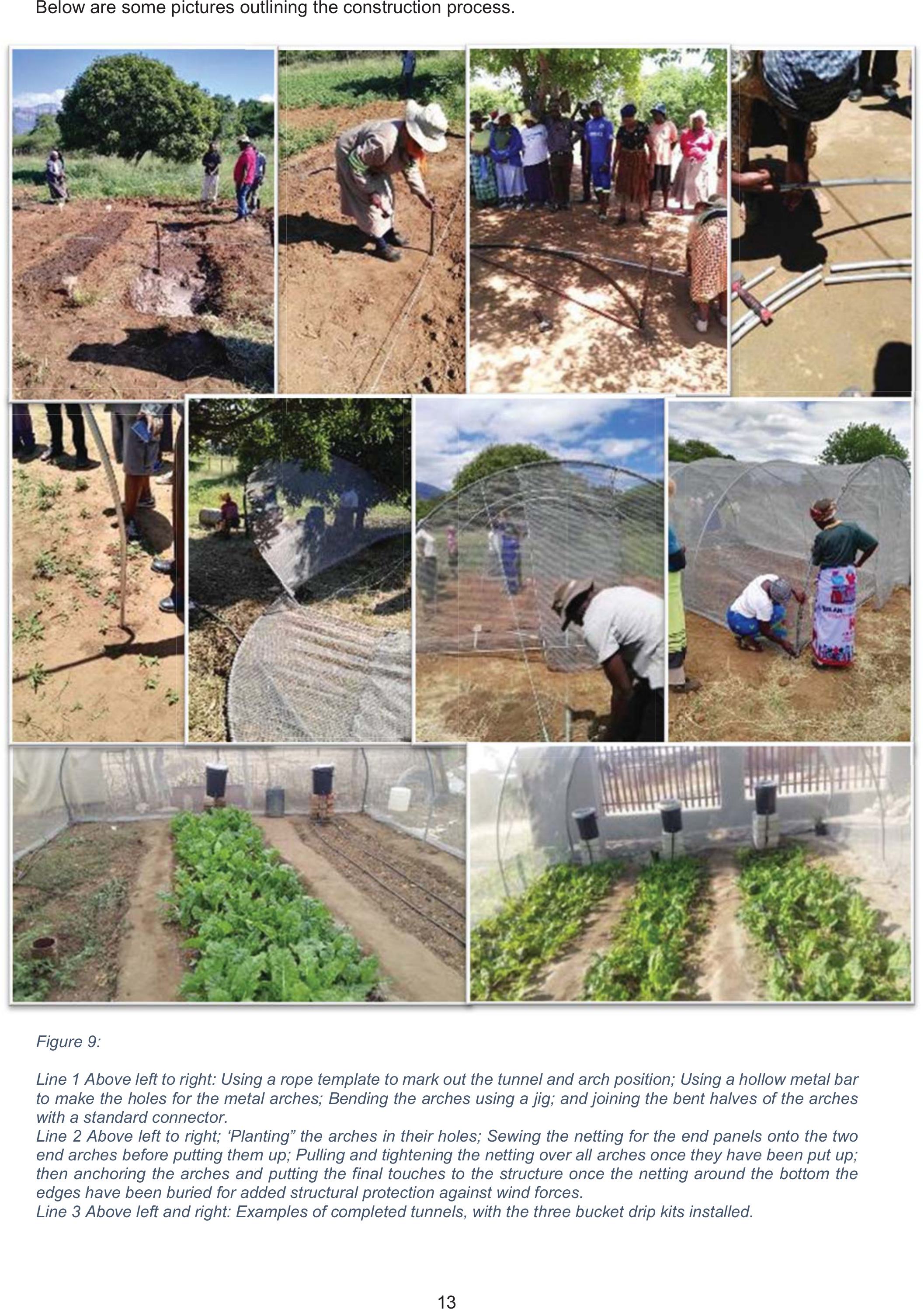
13
Below are some pictures outlining the construction process.
Figure 9:
Line 1 Above left to right: Using a rope template to mark out the tunnel and arch position; Using a hollow metal bar
to make the holes for the metal arches; Bending the arches using a jig; and joining the bent halves of the arches
with a standard connector.
Line 2 Above left to right; ‘Planting” the arches in their holes; Sewing the netting for the end panels onto the two
end arches before putting them up; Pulling and tightening the netting over all arches once they have been put up;
then anchoring the arches and putting the final touches to the structure once the netting around the bottom the
edges have been buried for added structural protection against wind forces.
Line 3 Above left and right: Examples of completed tunnels, with the three bucket drip kits installed.
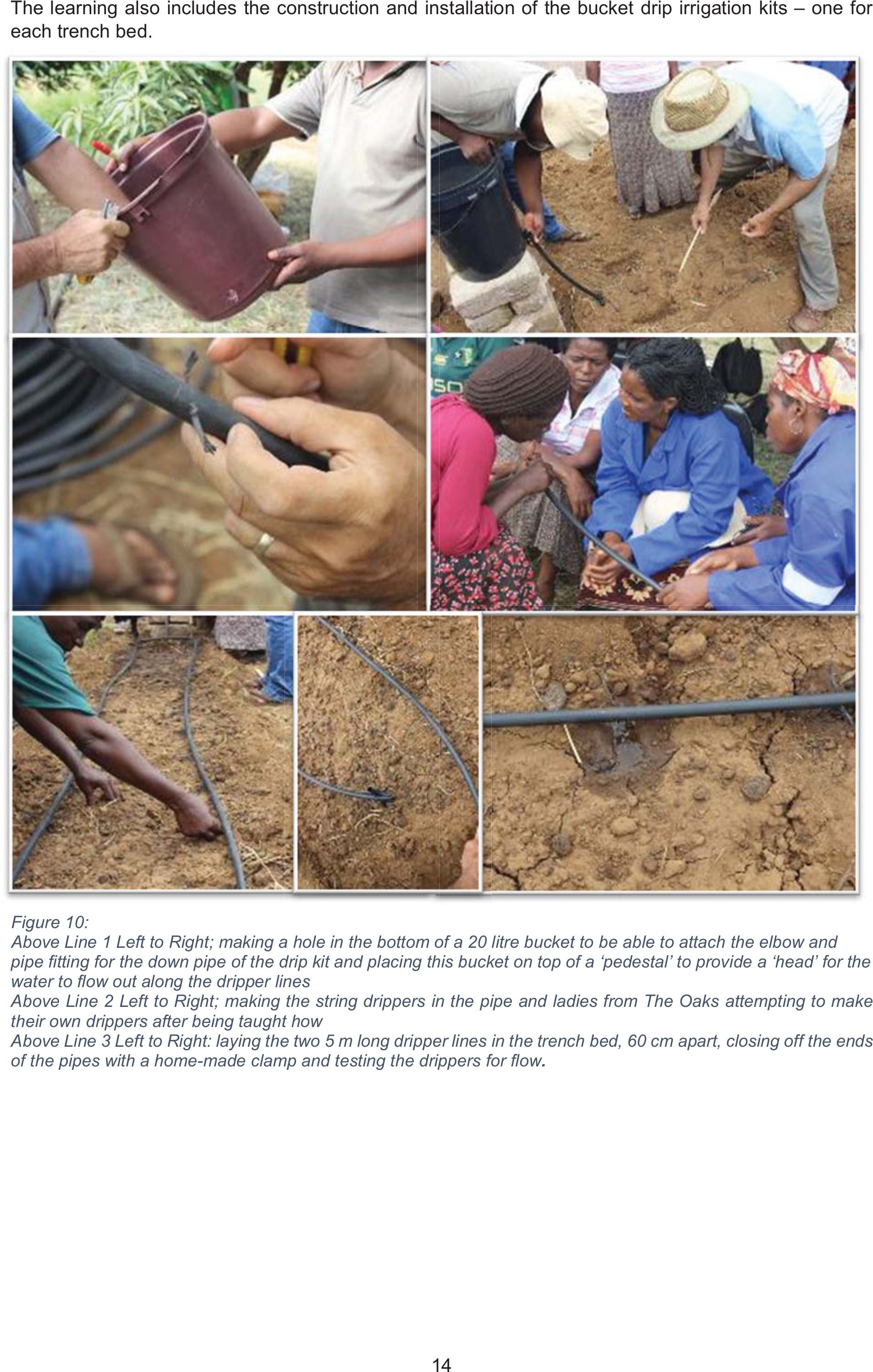
14
The learning also includes the construction and installation of the bucket drip irrigation kits – one for
each trench bed.
Figure 10:
Above Line 1 Left to Right; making a hole in the bottom of a 20 litre bucket to be able to attach the elbow and
pipe fitting for the down pipe of the drip kit and placing this bucket on top of a ‘pedestal’ to provide a ‘head’ for the
water to flow out along the dripper lines
Above Line 2 Left to Right; making the string drippers in the pipe and ladies from The Oaks attempting to make
their own drippers after being taught how
Above Line 3 Left to Right: laying the two 5 m long dripper lines in the trench bed, 60 cm apart, closing off the ends
of the pipes with a home-made clamp and testing the drippers for flow.
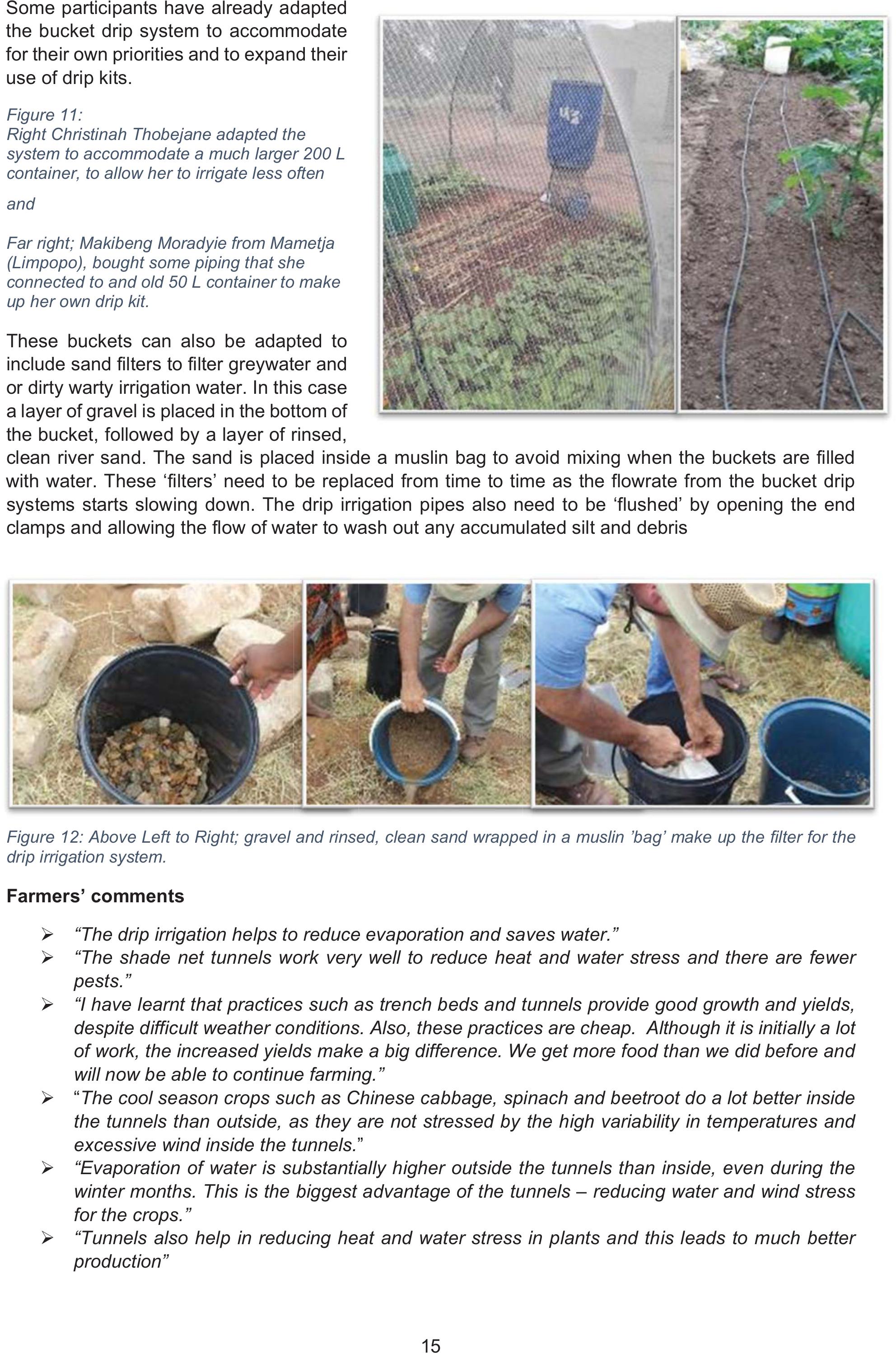
15
Some participants have already adapted
the bucket drip system to accommodate
for their own priorities and to expand their
use of drip kits.
Figure 11:
Right Christinah Thobejane adapted the
system to accommodate a much larger 200 L
container, to allow her to irrigate less often
and
Far right; Makibeng Moradyie from Mametja
(Limpopo), bought some piping that she
connected to and old 50 L container to make
up her own drip kit.
These buckets can also be adapted to
include sand filters to filter greywater and
or dirty warty irrigation water. In this case
a layer of gravel is placed in the bottom of
the bucket, followed by a layer of rinsed,
clean river sand. The sand is placed inside a muslin bag to avoid mixing when the buckets are filled
with water. These ‘filters’ need to be replaced from time to time as the flowrate from the bucket drip
systems starts slowing down. The drip irrigation pipes also need to be ‘flushed’ by opening the end
clamps and allowing the flow of water to wash out any accumulated silt and debris
Figure 12: Above Left to Right; gravel and rinsed, clean sand wrapped in a muslin ’bag’ make up the filter for the
drip irrigation system.
Farmers’ comments
¾“The drip irrigation helps to reduce evaporation and saves water.”
¾“The shade net tunnels work very well to reduce heat and water stress and there are fewer
pests.”
¾“I have learnt that practices such as trench beds and tunnels provide good growth and yields,
despite difficult weather conditions. Also, these practices are cheap. Although it is initially a lot
of work, the increased yields make a big difference. We get more food than we did before and
will now be able to continue farming.”
¾ “The cool season crops such as Chinese cabbage, spinach and beetroot do a lot better inside
the tunnels than outside, as they are not stressed by the high variability in temperatures and
excessive wind inside the tunnels.”
¾“Evaporation of water is substantially higher outside the tunnels than inside, even during the
winter months. This is the biggest advantage of the tunnels – reducing water and wind stress
for the crops.”
¾“Tunnels also help in reducing heat and water stress in plants and this leads to much better
production”
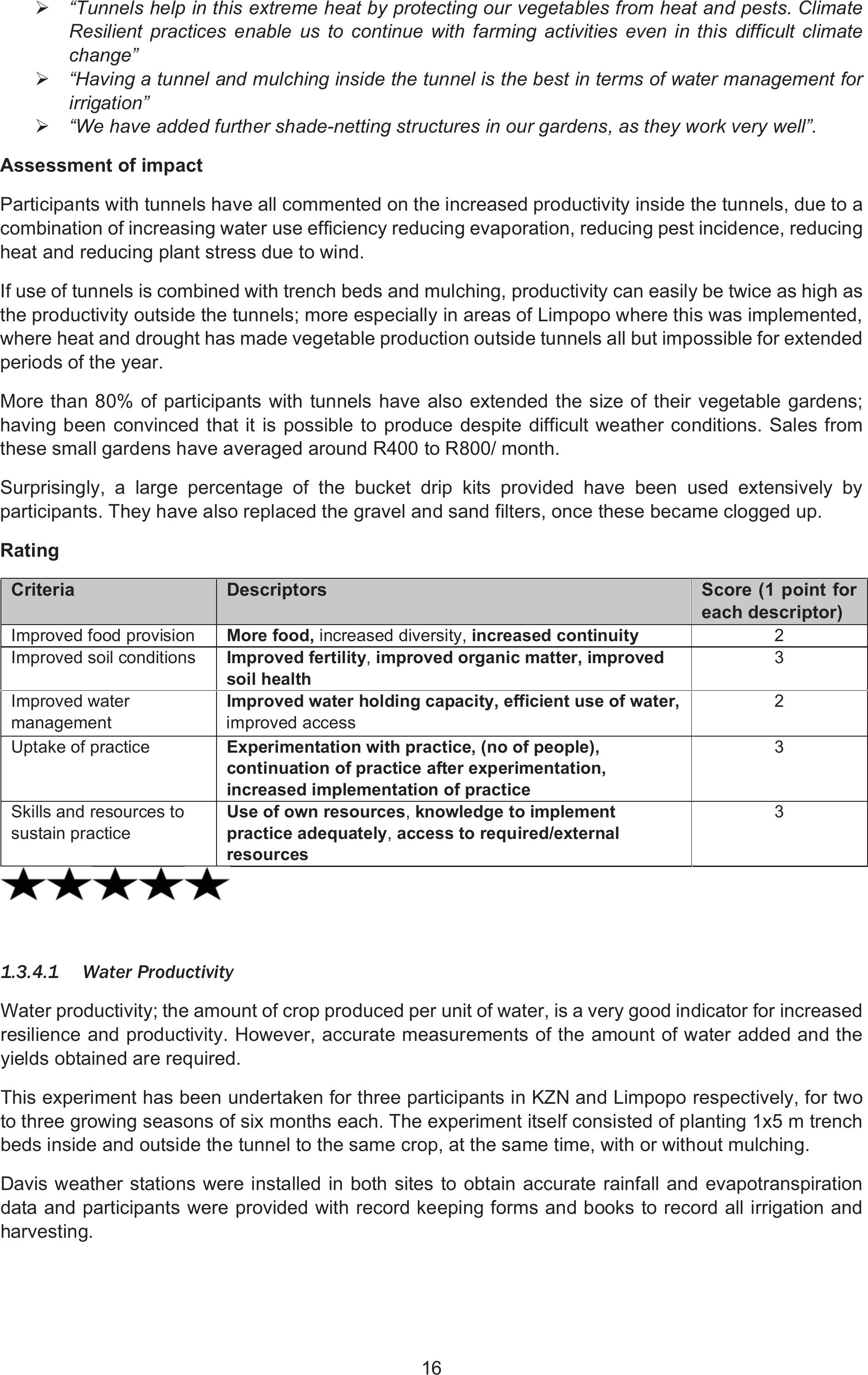
16
¾“Tunnels help in this extreme heat by protecting our vegetables from heat and pests. Climate
Resilient practices enable us to continue with farming activities even in this difficult climate
change”
¾“Having a tunnel and mulching inside the tunnel is the best in terms of water management for
irrigation”
¾“We have added further shade-netting structures in our gardens, as they work very well”.
Assessment of impact
Participants with tunnels have all commented on the increased productivity inside the tunnels, due to a
combination of increasing water use efficiency reducing evaporation, reducing pest incidence, reducing
heat and reducing plant stress due to wind.
If use of tunnels is combined with trench beds and mulching, productivity can easily be twice as high as
the productivity outside the tunnels; more especially in areas of Limpopo where this was implemented,
where heat and drought has made vegetable production outside tunnels all but impossible for extended
periods of the year.
More than 80% of participants with tunnels have also extended the size of their vegetable gardens;
having been convinced that it is possible to produce despite difficult weather conditions. Sales from
these small gardens have averaged around R400 to R800/ month.
Surprisingly, a large percentage of the bucket drip kits provided have been used extensively by
participants. They have also replaced the gravel and sand filters, once these became clogged up.
Rating
Criteria Descriptors Score (1 point for
each descriptor)
Improved food provision More food, increased diversity, increased continuity 2
Improved soil conditions Improved fertility, improved organic matter, improved
soil health
3
Improved water
management
Improved water holding capacity, efficient use of water,
improved access
2
Uptake of practice Experimentation with practice, (no of people),
continuation of practice after experimentation,
increased implementation of practice
3
Skills and resources to
sustain practice
Use of own resources, knowledge to implement
practice adequately, access to required/external
resources
3
1.3.4.1Water Productivity
Water productivity; the amount of crop produced per unit of water, is a very good indicator for increased
resilience and productivity. However, accurate measurements of the amount of water added and the
yields obtained are required.
This experiment has been undertaken for three participants in KZN and Limpopo respectively, for two
to three growing seasons of six months each. The experiment itself consisted of planting 1x5 m trench
beds inside and outside the tunnel to the same crop, at the same time, with or without mulching.
Davis weather stations were installed in both sites to obtain accurate rainfall and evapotranspiration
data and participants were provided with record keeping forms and books to record all irrigation and
harvesting.
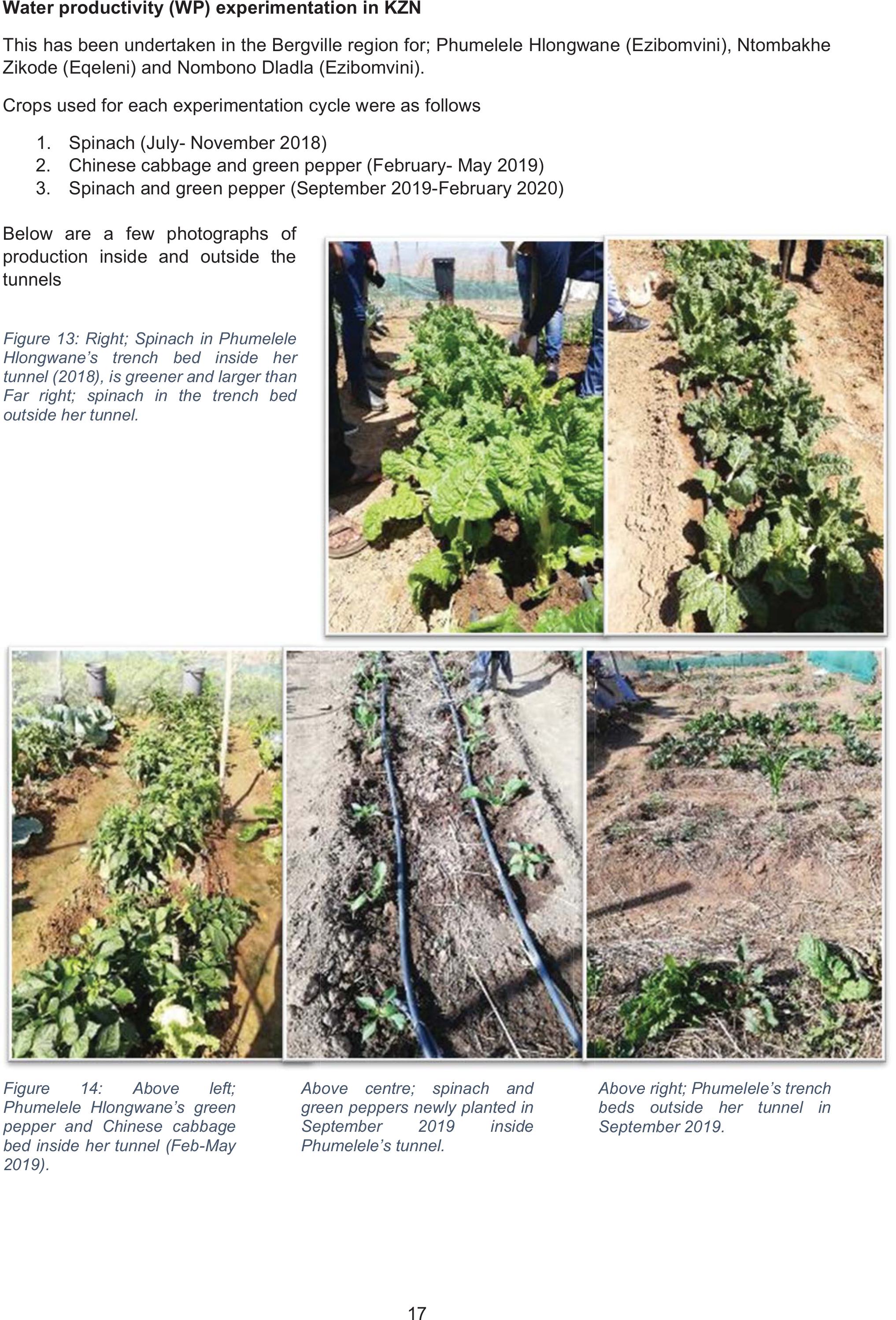
17
Water productivity (WP) experimentation in KZN
This has been undertaken in the Bergville region for; Phumelele Hlongwane (Ezibomvini), Ntombakhe
Zikode (Eqeleni) and Nombono Dladla (Ezibomvini).
Crops used for each experimentation cycle were as follows
1. Spinach (July- November 2018)
2. Chinese cabbage and green pepper (February- May 2019)
3. Spinach and green pepper (September 2019-February 2020)
Below are a few photographs of
production inside and outside the
tunnels
Figure 13: Right; Spinach in Phumelele
Hlongwane’s trench bed inside her
tunnel (2018), is greener and larger than
Far right; spinach in the trench bed
outside her tunnel.
Figure 14: Above left;
Phumelele Hlongwane’s green
pepper and Chinese cabbage
bed inside her tunnel (Feb-May
2019).
Above centre; spinach and
green peppers newly planted in
September 2019 inside
Phumelele’s tunnel.
Above right; Phumelele’s trench
beds outside her tunnel in
September 2019.
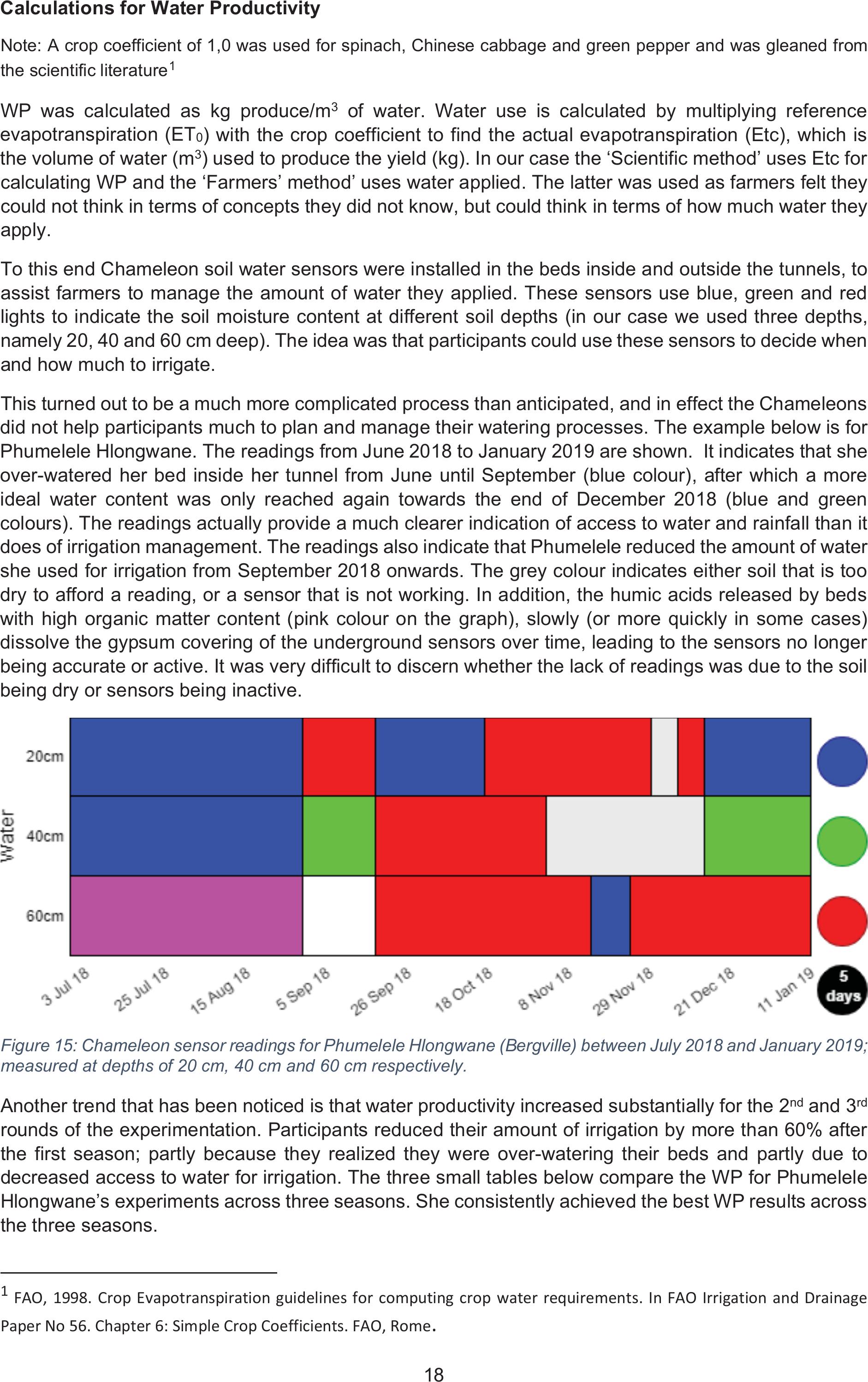
18
Calculations for Water Productivity
Note: A crop coefficient of 1,0 was used for spinach, Chinese cabbage and green pepper and was gleaned from
the scientific literature1
WP was calculated as kg produce/m3 of water. Water use is calculated by multiplying reference
evapotranspiration (ET0) with the crop coefficient to find the actual evapotranspiration (Etc), which is
the volume of water (m3) used to produce the yield (kg). In our case the ‘Scientific method’ uses Etc for
calculating WP and the ‘Farmers’ method’ uses water applied. The latter was used as farmers felt they
could not think in terms of concepts they did not know, but could think in terms of how much water they
apply.
To this end Chameleon soil water sensors were installed in the beds inside and outside the tunnels, to
assist farmers to manage the amount of water they applied. These sensors use blue, green and red
lights to indicate the soil moisture content at different soil depths (in our case we used three depths,
namely 20, 40 and 60 cm deep). The idea was that participants could use these sensors to decide when
and how much to irrigate.
This turned out to be a much more complicated process than anticipated, and in effect the Chameleons
did not help participants much to plan and manage their watering processes. The example below is for
Phumelele Hlongwane. The readings from June 2018 to January 2019 are shown. It indicates that she
over-watered her bed inside her tunnel from June until September (blue colour), after which a more
ideal water content was only reached again towards the end of December 2018 (blue and green
colours). The readings actually provide a much clearer indication of access to water and rainfall than it
does of irrigation management. The readings also indicate that Phumelele reduced the amount of water
she used for irrigation from September 2018 onwards. The grey colour indicates either soil that is too
dry to afford a reading, or a sensor that is not working. In addition, the humic acids released by beds
with high organic matter content (pink colour on the graph), slowly (or more quickly in some cases)
dissolve the gypsum covering of the underground sensors over time, leading to the sensors no longer
being accurate or active. It was very difficult to discern whether the lack of readings was due to the soil
being dry or sensors being inactive.
Figure 15: Chameleon sensor readings for Phumelele Hlongwane (Bergville) between July 2018 and January 2019;
measured at depths of 20 cm, 40 cm and 60 cm respectively.
Another trend that has been noticed is that water productivity increased substantially for the 2nd and 3rd
rounds of the experimentation. Participants reduced their amount of irrigation by more than 60% after
the first season; partly because they realized they were over-watering their beds and partly due to
decreased access to water for irrigation. The three small tables below compare the WP for Phumelele
Hlongwane’s experiments across three seasons. She consistently achieved the best WP results across
the three seasons.
1 FAO, 1998. Crop Evapotranspiration guidelines for computing crop water requirements. In FAO Irrigation and Drainage
Paper No 56. Chapter 6: Simple Crop Coefficients. FAO, Rome.
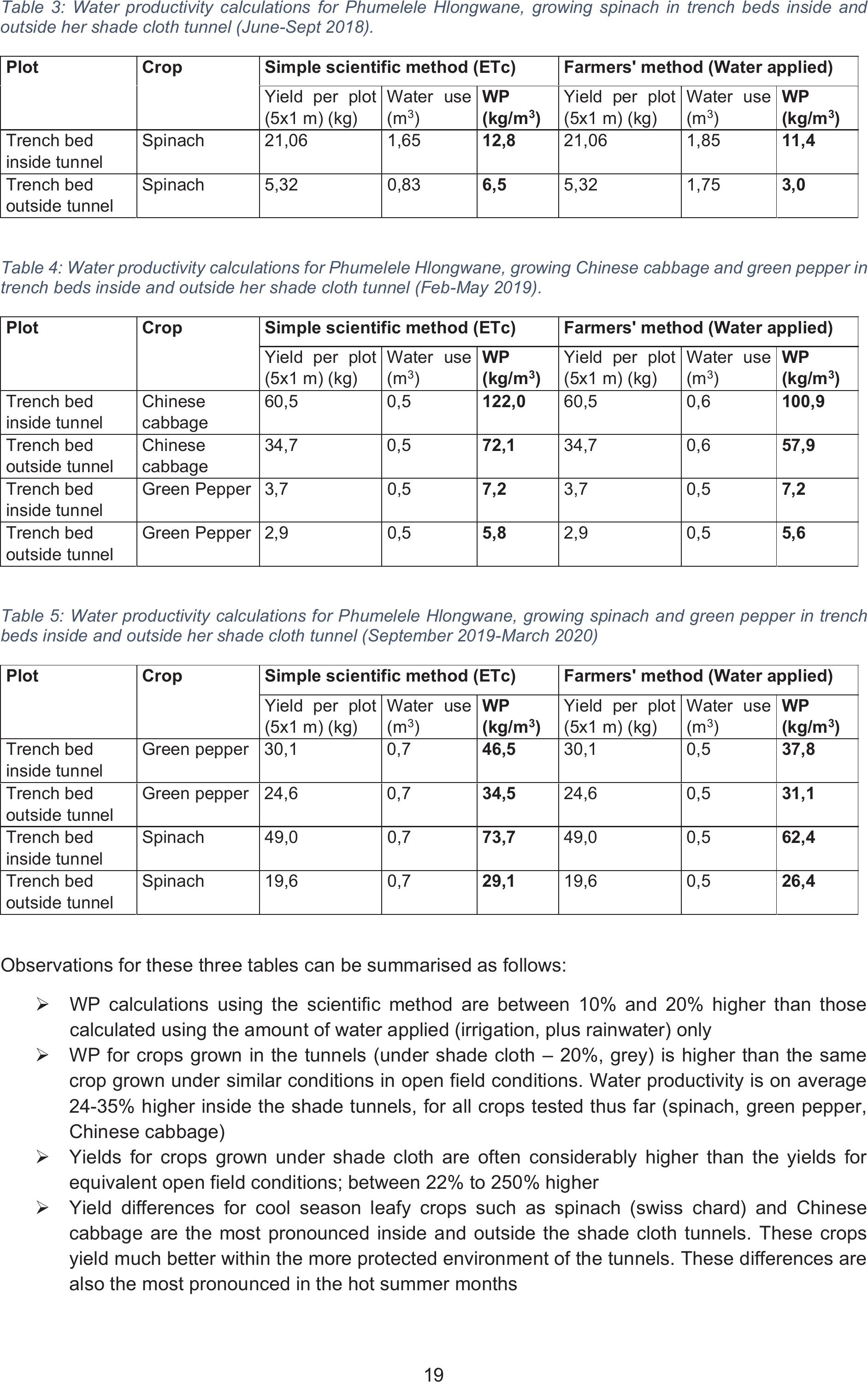
19
Table 3: Water productivity calculations for Phumelele Hlongwane, growing spinach in trench beds inside and
outside her shade cloth tunnel (June-Sept 2018).
Plot Crop Simple scientific method (ETc)Farmers' method (Water applied)
Yield per plot
(5x1 m) (kg)
Water use
(m3)
WP
(kg/m3)
Yield per plot
(5x1 m) (kg)
Water use
(m3)
WP
(kg/m3)
Trench bed
inside tunnel
Spinach 21,061,65 12,8 21,06 1,85 11,4
Trench bed
outside tunnel
Spinach 5,320,836,5 5,32 1,75 3,0
Table 4: Water productivity calculations for Phumelele Hlongwane, growing Chinese cabbage and green pepper in
trench beds inside and outside her shade cloth tunnel (Feb-May 2019).
Plot Crop Simple scientific method (ETc)Farmers' method (Water applied)
Yield per plot
(5x1 m) (kg)
Water use
(m3)
WP
(kg/m3)
Yield per plot
(5x1 m) (kg)
Water use
(m3)
WP
(kg/m3)
Trench bed
inside tunnel
Chinese
cabbage
60,5 0,5 122,060,5 0,6 100,9
Trench bed
outside tunnel
Chinese
cabbage
34,7 0,5 72,134,7 0,6 57,9
Trench bed
inside tunnel
Green Pepper3,7 0,5 7,2 3,7 0,5 7,2
Trench bed
outside tunnel
Green Pepper2,9 0,5 5,8 2,9 0,5 5,6
Table 5: Water productivity calculations for Phumelele Hlongwane, growing spinach and green pepper in trench
beds inside and outside her shade cloth tunnel (September 2019-March 2020)
Plot Crop Simple scientific method (ETc)Farmers' method (Water applied)
Yield per plot
(5x1 m) (kg)
Water use
(m3)
WP
(kg/m3)
Yield per plot
(5x1 m) (kg)
Water use
(m3)
WP
(kg/m3)
Trench bed
inside tunnel
Green pepper30,1 0,7 46,5 30,1 0,5 37,8
Trench bed
outside tunnel
Green pepper24,6 0,7 34,5 24,6 0,5 31,1
Trench bed
inside tunnel
Spinach 49,0 0,7 73,7 49,0 0,5 62,4
Trench bed
outside tunnel
Spinach 19,6 0,7 29,1 19,6 0,5 26,4
Observations for these three tables can be summarised as follows:
¾WP calculations using the scientific method are between 10% and 20% higher than those
calculated using the amount of water applied (irrigation, plus rainwater) only
¾WP for crops grown in the tunnels (under shade cloth – 20%, grey) is higher than the same
crop grown under similar conditions in open field conditions. Water productivity is on average
24-35% higher inside the shade tunnels, for all crops tested thus far (spinach, green pepper,
Chinese cabbage)
¾Yields for crops grown under shade cloth are often considerably higher than the yields for
equivalent open field conditions; between 22% to 250% higher
¾Yield differences for cool season leafy crops such as spinach (swiss chard) and Chinese
cabbage are the most pronounced inside and outside the shade cloth tunnels. These crops
yield much better within the more protected environment of the tunnels. These differences are
also the most pronounced in the hot summer months

20
¾WP for spinach was initially calculated as 12,8 kg/m3 for the 2018 winter season. (trench inside
tunnel). The WP shot up to 73,7 kg/m3 for the summer growing season going into 2020. For the
same crop. This is considered to be due to more effective irrigation and increased fertility in the
trench beds as they “mature”. These values however are not directly comparable, given that
¾one crop was produced during the winter season and the other during the summer season
Water productivity (WP) experimentation in Limpopo
This has been undertaken in the Mametja region for Christina Thobejane (Sedawa), Norah Mahlaku
(Sedawa) and Makibeng Moradiya (Mametja).
Crops used for each experimentation cycle were as follows:
1. Spinach (April-July 2018)
2. Spinach, chilli and leek (June-September 2019)
Participants with chameleons undertook to record irrigation and harvests for a 2nd season, (June-
September 2019), but most stopped their record keeping around June-July 2019 due to severe water
shortages in the villages. They stopped watering their beds outside the tunnels and focused on keeping
small quantities of crops inside their tunnels alive. It was thus not possible to do a second round of
water productivity calculations. One participant however made a brave attempt and her calculations are
presented below. During the 2nd season participants planted their own crop combinations and used
crops for selling through the organic marketing system set up in the area and for household
consumption.
Below, the WP calculations are presented for two participants for April-July in 2018. They both planted
spinach in trench beds inside and outside their tunnels and used the traditional furrow and ridges
planting method as a control.
Table 6: Water productivity calculations for two participants, growing spinach inside their shade cloth tunnels, in
trench beds with and without mulch, and outside the tunnel on furrows and ridges with mulch (Sedawa, Limpopo);
April-July 2018
Plot Crop Simple scientific method (ETc)Farmers' method (Water applied)
Yield per plot
(kg)
Water use
(m3)
WP
(kg/m3)
Yield per plot
(kg)
Water use
(m3)
WP
(kg/m3)
Christina Thobejane,
inside tunnel,
trench bed
with mulch (5 m2)
Spinach 48,9 0,8 61,7 48,9 1,1 56,7
Christina Thobejane,
outside tunnel,
furrows and ridges
with mulch (3,5 m2)
Spinach 24,5 0,5 44,0 24,5 3,9 5
Nora Mahlako,
inside tunnel,
trench bed
without mulch (5 m2)
Spinach 19,6 0,8 24,7 19,6 9,5 5
Note 1: Both participants stopped irrigating some of their beds due to a lack of water and these results could not be included.
Observations from the table can be summarised as follows:
¾For Christina; the WP for the trench bed inside the tunnel is ~70% higher than the furrows and
ridges control planting, when looking at the scientific method of calculation. Yields inside the
tunnel were double that of the traditional planting method of furrows and ridges, which were
outside the tunnel.
¾Christina mentioned that she changed the way she does watering, based on her Chameleon
readings and opted for deep watering once or twice a week, rather than using small amounts of
irrigation on a daily basis.

21
¾For Norah’s tunnel the situation is quite different. She did not do mulching and she kept to the
‘traditional’ watering practice of a little in the morning and a little in the evening every day. She
has used a lot more water than Christina did inside her tunnel (9,5 m3 vs 1,1 m3), but her process
was significantly less productive (19,6 kg of spinach vs 48,9 kg of spinach). This indicates that
her practices greatly increased the required amount of water, without increasing the efficiency
of use of this water. This is a significant difference in yield brought about by a number of factors,
as observed and discussed with the farmers:
oMulching and deep watering inside the tunnel vs no mulching and repetitive shallow
watering
oHarvesting practices; another aspect mentioned by farmers when analysing these
results is that it is possible that Norah overharvested her spinach, with the outcome
that regrowth and further harvesting was reduced
oFarmers also mentioned that there is generally more shade from trees, in Christina’s
garden, even her tunnel is provided with some shade during the day, while Norah’s
tunnel has no shade
oDifferent planting times; this could in fact have played a large part in the WP differences
in the two tunnels as Norah planted at the end of February (when it was very hot) and
Christina planted at the beginning of April (when it was much cooler).
These results give a clear indication of the productive advantage of using tunnels in these hot, dry
conditions and further show the added yield and water productivity advantages of mulching and deep
watering as crop management practices. Chameleon sensor readings further demonstrate the above
analysis.
Figure 16: Chameleon sensor readings for Christina Thobejane’s trench bed inside her tunnel between January
and August 2018
This data indicates 58% blue, 15% green and 17% red readings throughout this period and is a good
example of reasonable irrigation management. The data set for the furrows and ridges look similar, as
shown below, but she had to use 3,5 times more water on the furrows and ridges, when compared to
the trench inside the tunnel to achieve this result
Figure 17: Chameleon sensor readings for Christina Thobejane’s furrows and ridges outside her tunnel between
March and July 2018

22
Norah Mahlaku’s Chameleon sensor readings for her trench bed inside her showed under watering
(26% blue, 4% green and 70% red) during the same period despite the fact that she used 8,6 times
more water than Christina did in her tunnel trench bed.
Figure 18: Chameleon sensor readings for Norah Mahlaku’s trench bed inside her tunnel between January and
August 2018
Christina has made the following comments about the chameleons:
¾Applying water until the chameleon changes colour (goes blue) seems to be a good idea as this
saves her some water and means that she only has to irrigate once a week (every 7 days).
¾She has thus now changed her irrigation practice of watering a little every morning and afternoon,
to a deep watering every 5-7 days. Even though this was discussed in the learning workshops,
she was not convinced until she managed to work it out for herself.
¾The chameleon in the tunnel stays blue (indicating enough water in the soil) for longer than in the
other beds.
¾She appreciates the ease of using the chameleons – by just checking the colour.
¾She felt that all the weighing and recording of water applied was time consuming and
unnecessary, since she could visually see the difference in the plants.
¾Another difficulty lay in the reading the data from the chameleons, as this was often frustrated by
small wires coming loose in the chameleon array. Uploading this data was also a bit problematic,
given that it required a sizeable amount of data, along with good cell phone reception.
Figure 19:
Right; An example of a
Chameleon sensor in this case
indicating blue, green and red for
the three different soil depths
(20, 40 and 60 cm respectively)
Far right; Sylvester Selala in
Christina’s tunnel checking the
sensor.
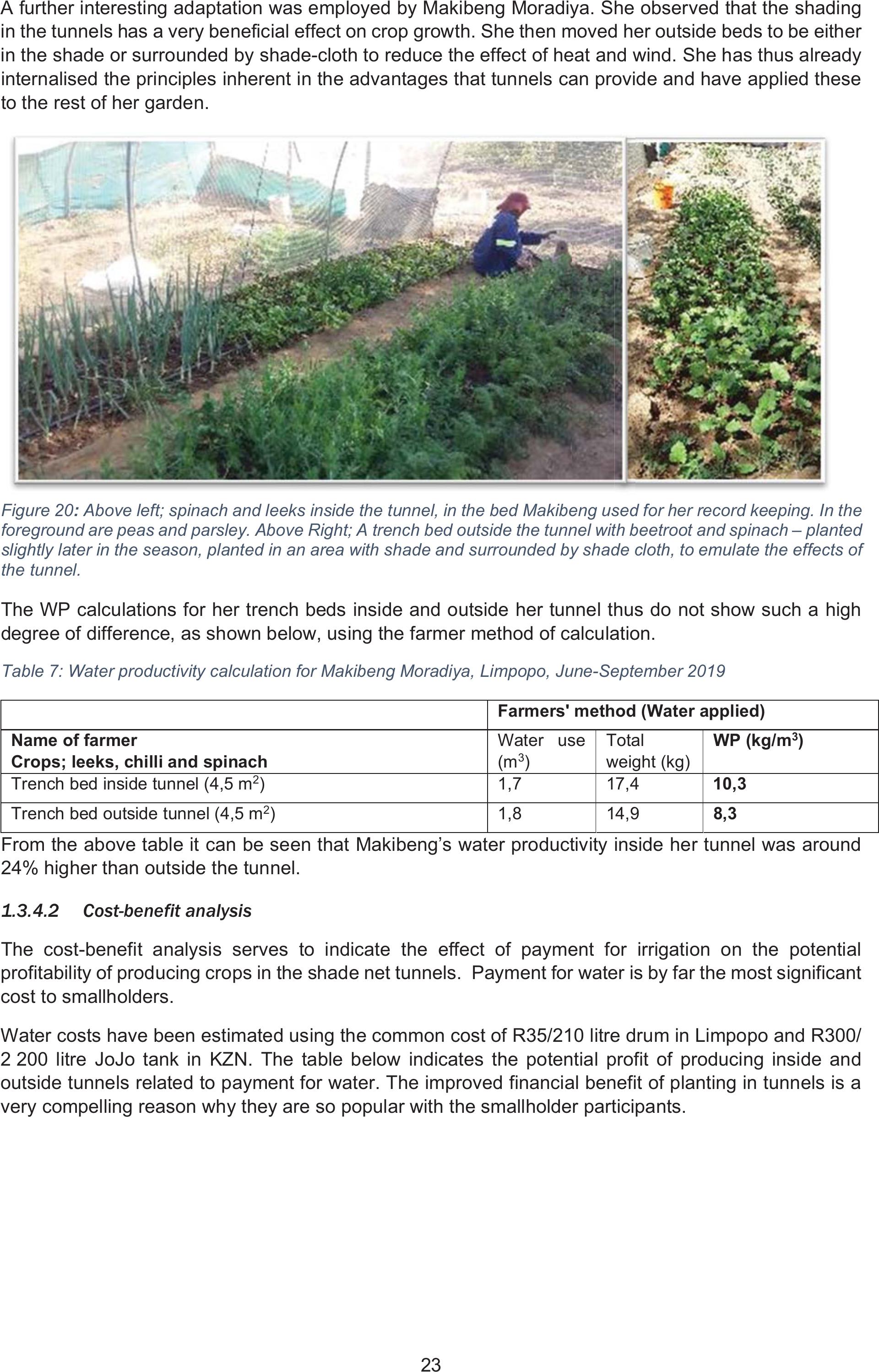
23
A further interesting adaptation was employed by Makibeng Moradiya. She observed that the shading
in the tunnels has a very beneficial effect on crop growth. She then moved her outside beds to be either
in the shade or surrounded by shade-cloth to reduce the effect of heat and wind. She has thus already
internalised the principles inherent in the advantages that tunnels can provide and have applied these
to the rest of her garden.
Figure 20: Above left; spinach and leeks inside the tunnel, in the bed Makibeng used for her record keeping. In the
foreground are peas and parsley. Above Right; A trench bed outside the tunnel with beetroot and spinach – planted
slightly later in the season, planted in an area with shade and surrounded by shade cloth, to emulate the effects of
the tunnel.
The WP calculations for her trench beds inside and outside her tunnel thus do not show such a high
degree of difference, as shown below, using the farmer method of calculation.
Table 7: Water productivity calculation for Makibeng Moradiya, Limpopo, June-September 2019
Farmers' method (Water applied)
Name of farmer
Crops; leeks, chilli and spinach
Water use
(m3)
Total
weight (kg)
WP (kg/m3)
Trench bed inside tunnel (4,5 m2) 1,717,4 10,3
Trench bed outside tunnel (4,5 m2) 1,814,9 8,3
From the above table it can be seen that Makibeng’s water productivity inside her tunnel was around
24% higher than outside the tunnel.
1.3.4.2Cost-benefit analysis
The cost-benefit analysis serves to indicate the effect of payment for irrigation on the potential
profitability of producing crops in the shade net tunnels. Payment for water is by far the most significant
cost to smallholders.
Water costs have been estimated using the common cost of R35/210 litre drum in Limpopo and R300/
2 200 litre JoJo tank in KZN. The table below indicates the potential profit of producing inside and
outside tunnels related to payment for water. The improved financial benefit of planting in tunnels is a
very compelling reason why they are so popular with the smallholder participants.
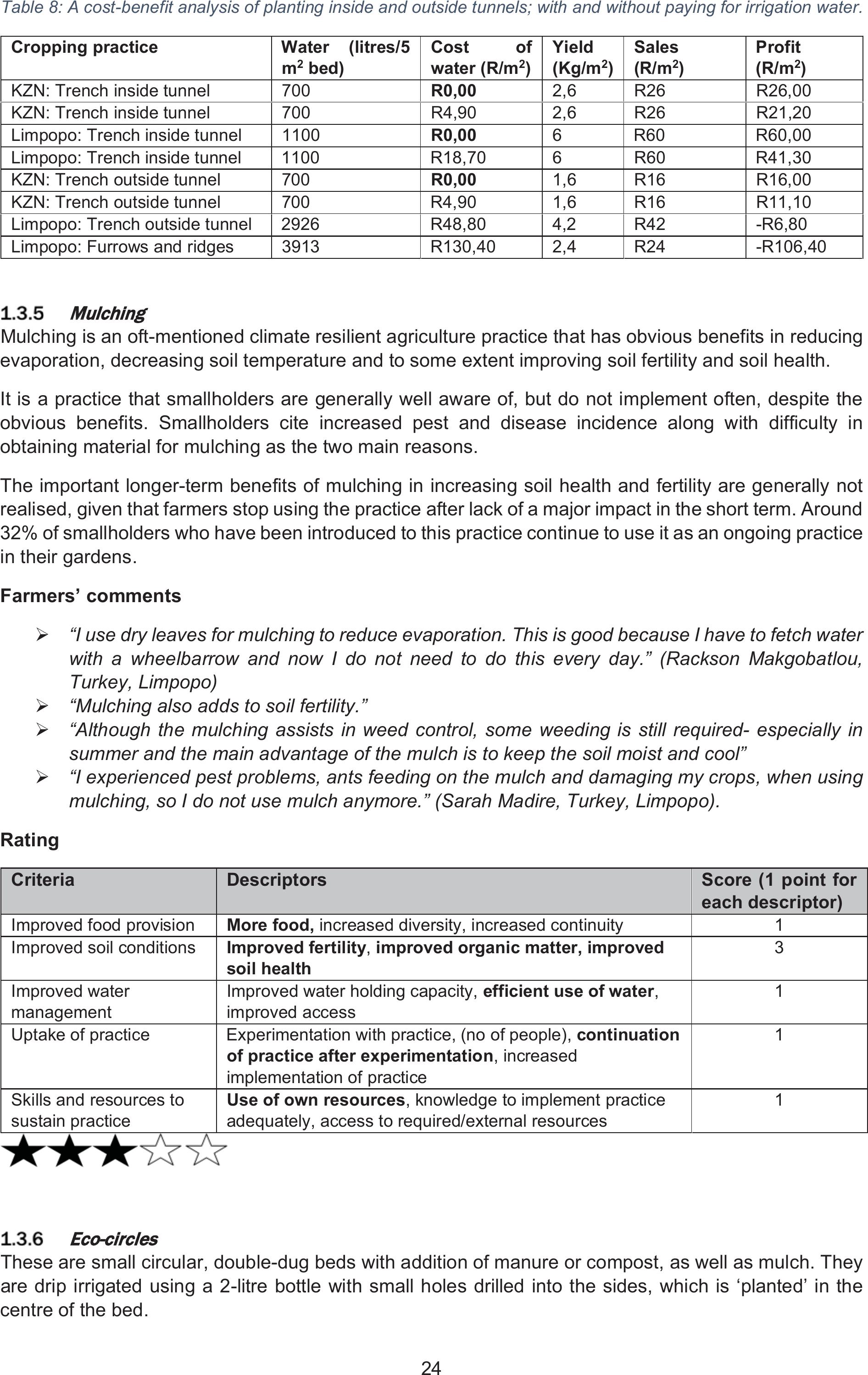
24
Table 8: A cost-benefit analysis of planting inside and outside tunnels; with and without paying for irrigation water.
Cropping practice Water (litres/5
m2 bed)
Cost of
water (R/m2)
Yield
(Kg/m2)
Sales
(R/m2)
Profit
(R/m2)
KZN: Trench inside tunnel 700 R0,00 2,6 R26R26,00
KZN: Trench inside tunnel 700 R4,90 2,6 R26R21,20
Limpopo: Trench inside tunnel 1100 R0,00 6 R60R60,00
Limpopo: Trench inside tunnel 1100 R18,70 6R60R41,30
KZN: Trench outside tunnel700 R0,00 1,6 R16R16,00
KZN: Trench outside tunnel700 R4,90 1,6 R16R11,10
Limpopo: Trench outside tunnel2926R48,80 4,2R42-R6,80
Limpopo: Furrows and ridges 3913 R130,402,4 R24-R106,40
M
Mulching
Mulching is an oft-mentioned climate resilient agriculture practice that has obvious benefits in reducing
evaporation, decreasing soil temperature and to some extent improving soil fertility and soil health.
It is a practice that smallholders are generally well aware of, but do not implement often, despite the
obvious benefits. Smallholders cite increased pest and disease incidence along with difficulty in
obtaining material for mulching as the two main reasons.
The important longer-term benefits of mulching in increasing soil health and fertility are generally not
realised, given that farmers stop using the practice after lack of a major impact in the short term. Around
32% of smallholders who have been introduced to this practice continue to use it as an ongoing practice
in their gardens.
Farmers’ comments
¾“I use dry leaves for mulching to reduce evaporation. This is good because I have to fetch water
with a wheelbarrow and now I do not need to do this every day.” (Rackson Makgobatlou,
Turkey, Limpopo)
¾“Mulching also adds to soil fertility.”
¾“Although the mulching assists in weed control, some weeding is still required- especially in
summer and the main advantage of the mulch is to keep the soil moist and cool”
¾“I experienced pest problems, ants feeding on the mulch and damaging my crops, when using
mulching, so I do not use mulch anymore.” (Sarah Madire, Turkey, Limpopo).
Rating
Criteria Descriptors Score (1 point for
each descriptor)
Improved food provision More food, increased diversity, increased continuity 1
Improved soil conditions Improved fertility, improved organic matter, improved
soil health
3
Improved water
management
Improved water holding capacity, efficient use of water,
improved access
1
Uptake of practice Experimentation with practice, (no of people), continuation
of practice after experimentation, increased
implementation of practice
1
Skills and resources to
sustain practice
Use of own resources, knowledge to implement practice
adequately,access to required/external resources
1
Eco-circles
These are small circular, double-dug beds with addition of manure or compost, as well as mulch. They
are drip irrigated using a 2-litre bottle with small holes drilled into the sides, which is ‘planted’ in the
centre of the bed.
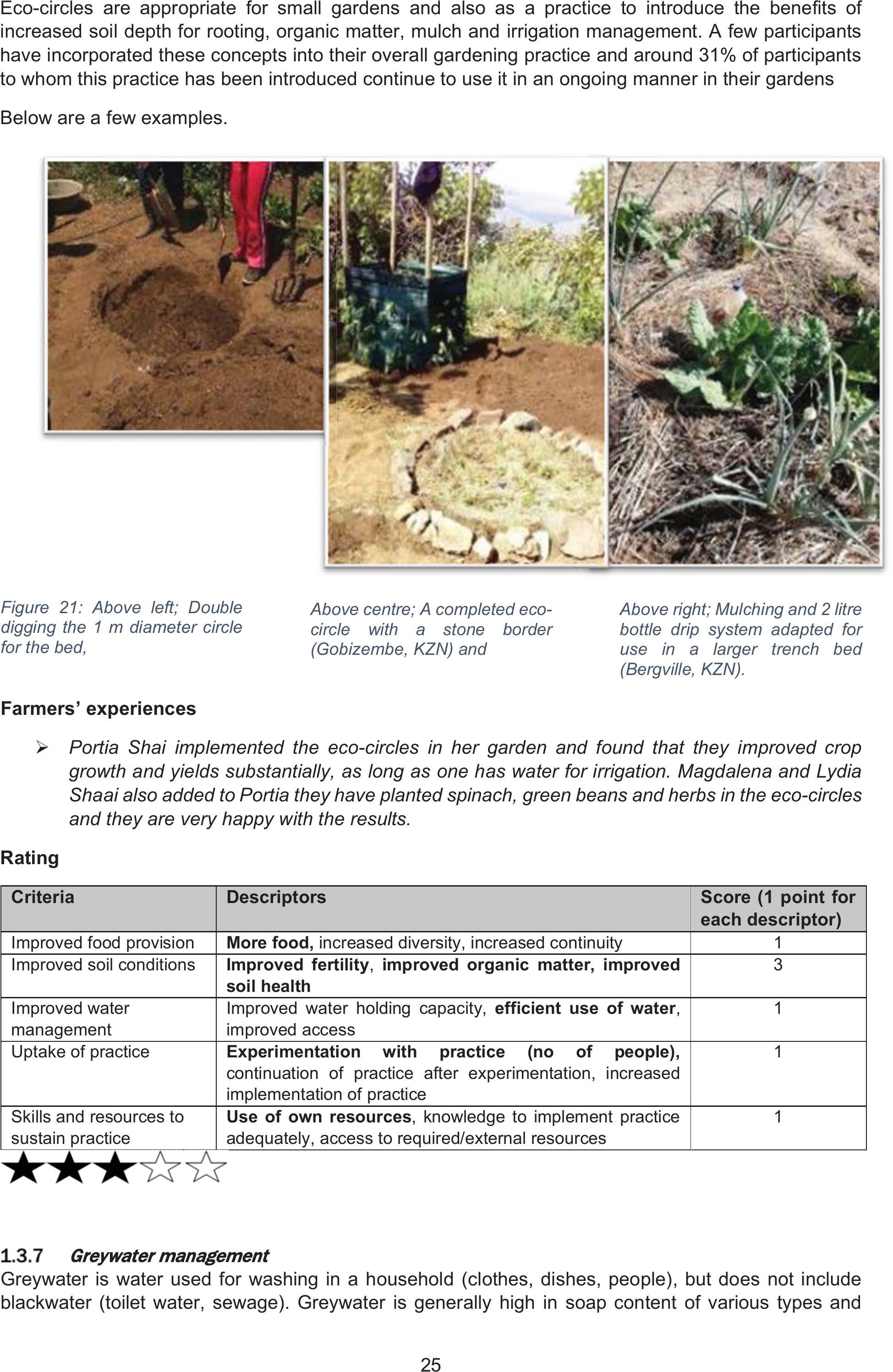
25
Eco-circles are appropriate for small gardens and also as a practice to introduce the benefits of
increased soil depth for rooting, organic matter, mulch and irrigation management. A few participants
have incorporated these concepts into their overall gardening practice and around 31% of participants
to whom this practice has been introduced continue to use it in an ongoing manner in their gardens
Below are a few examples.
Figure 21: Above left; Double
digging the 1 m diameter circle
for the bed,
Above centre; A completed eco-
circle with a stone border
(Gobizembe, KZN) and
Above right; Mulching and 2 litre
bottle drip system adapted for
use in a larger trench bed
(Bergville, KZN).
Farmers’ experiences
¾Portia Shai implemented the eco-circles in her garden and found that they improved crop
growth and yields substantially, as long as one has water for irrigation. Magdalena and Lydia
Shaai also added to Portia they have planted spinach, green beans and herbs in the eco-circles
and they are very happy with the results.
Rating
Criteria Descriptors Score (1 point for
each descriptor)
Improved food provision More food, increased diversity, increased continuity 1
Improved soil conditions Improved fertility, improved organic matter, improved
soil health
3
Improved water
management
Improved water holding capacity, efficient use of water,
improved access
1
Uptake of practice Experimentation with practice (no of people),
continuation of practice after experimentation, increased
implementation of practice
1
Skills and resources to
sustain practice
Use of own resources, knowledge to implement practice
adequately,access to required/external resources
1
G
Greywater management
Greywater is water used for washing in a household (clothes, dishes, people), but does not include
blackwater (toilet water, sewage). Greywater is generally high in soap content of various types and
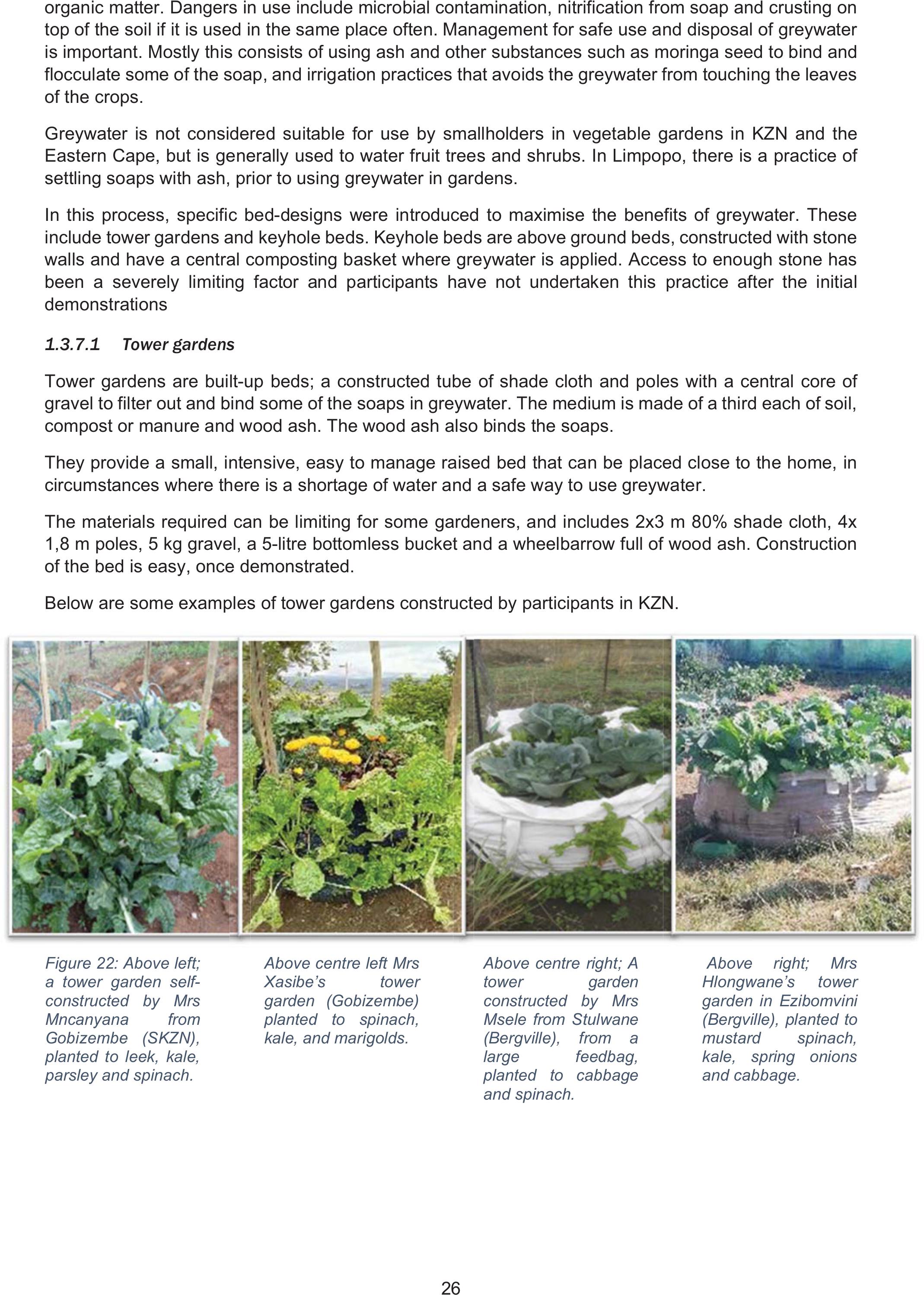
26
organic matter. Dangers in use include microbial contamination, nitrification from soap and crusting on
top of the soil if it is used in the same place often. Management for safe use and disposal of greywater
is important. Mostly this consists of using ash and other substances such as moringa seed to bind and
flocculate some of the soap, and irrigation practices that avoids the greywater from touching the leaves
of the crops.
Greywater is not considered suitable for use by smallholders in vegetable gardens in KZN and the
Eastern Cape, but is generally used to water fruit trees and shrubs. In Limpopo, there is a practice of
settling soaps with ash, prior to using greywater in gardens.
In this process, specific bed-designs were introduced to maximise the benefits of greywater. These
include tower gardens and keyhole beds. Keyhole beds are above ground beds, constructed with stone
walls and have a central composting basket where greywater is applied. Access to enough stone has
been a severely limiting factor and participants have not undertaken this practice after the initial
demonstrations
1.3.7.1Tower gardens
Tower gardens are built-up beds; a constructed tube of shade cloth and poles with a central core of
gravel to filter out and bind some of the soaps in greywater. The medium is made of a third each of soil,
compost or manure and wood ash. The wood ash also binds the soaps.
They provide a small, intensive, easy to manage raised bed that can be placed close to the home, in
circumstances where there is a shortage of water and a safe way to use greywater.
The materials required can be limiting for some gardeners, and includes 2x3 m 80% shade cloth, 4x
1,8 m poles, 5 kg gravel, a 5-litre bottomless bucket and a wheelbarrow full of wood ash. Construction
of the bed is easy, once demonstrated.
Below are some examples of tower gardens constructed by participants in KZN.
Figure 22: Above left;
a tower garden self-
constructed by Mrs
Mncanyana from
Gobizembe (SKZN),
planted to leek, kale,
parsley and spinach.
Above centre left Mrs
Xasibe’s tower
garden (Gobizembe)
planted to spinach,
kale, and marigolds.
Above centre right; A
tower garden
constructed by Mrs
Msele from Stulwane
(Bergville), from a
large feedbag,
planted to cabbage
and spinach.
Above right; Mrs
Hlongwane’s tower
garden in Ezibomvini
(Bergville), planted to
mustard spinach,
kale, spring onions
and cabbage.
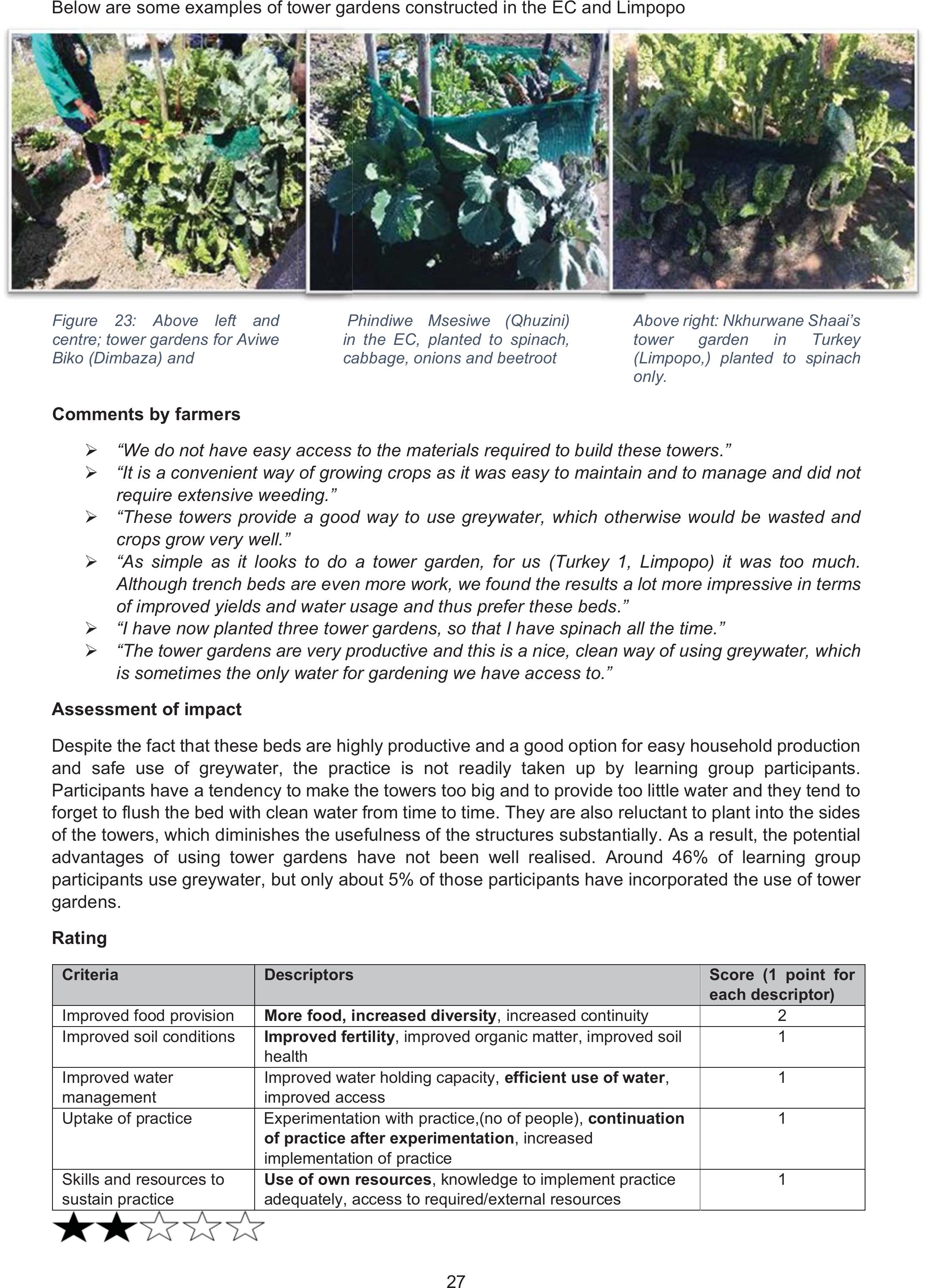
27
Below are some examples of tower gardens constructed in the EC and Limpopo
Figure 23: Above left and
centre; tower gardens for Aviwe
Biko (Dimbaza) and
Phindiwe Msesiwe(Qhuzini)
in the EC, planted to spinach,
cabbage, onions and beetroot
Above right: Nkhurwane Shaai’s
tower garden in Turkey
(Limpopo,) planted to spinach
only.
Comments by farmers
¾“We do not have easy access to the materials required to build these towers.”
¾“It is a convenient way of growing crops as it was easy to maintain and to manage and did not
require extensive weeding.”
¾“These towers provide a good way to use greywater, which otherwise would be wasted and
crops grow very well.”
¾“As simple as it looks to do a tower garden, for us (Turkey 1, Limpopo) it was too much.
Although trench beds are even more work, we found the results a lot more impressive in terms
of improved yields and water usage and thus prefer these beds.”
¾“I have now planted three tower gardens, so that I have spinach all the time.”
¾“The tower gardens are very productive and this is a nice, clean way of using greywater, which
is sometimes the only water for gardening we have access to.”
Assessment of impact
Despite the fact that these beds are highly productive and a good option for easy household production
and safe use of greywater, the practice is not readily taken up by learning group participants.
Participants have a tendency to make the towers too big and to provide too little water and they tend to
forget to flush the bed with clean water from time to time. They are also reluctant to plant into the sides
of the towers, which diminishes the usefulness of the structures substantially. As a result, the potential
advantages of using tower gardens have not been well realised. Around 46% of learning group
participants use greywater, but only about 5% of those participants have incorporated the use of tower
gardens.
Rating
Criteria Descriptors Score (1 point for
each descriptor)
Improved food provision More food, increased diversity, increased continuity 2
Improved soil conditions Improved fertility, improved organic matter, improved soil
health
1
Improved water
management
Improved water holding capacity, efficient use of water,
improved access
1
Uptake of practice Experimentation with practice,(no of people), continuation
of practice after experimentation, increased
implementation of practice
1
Skills and resources to
sustain practice
Use of own resources, knowledge to implement practice
adequately, access to required/external resources
1
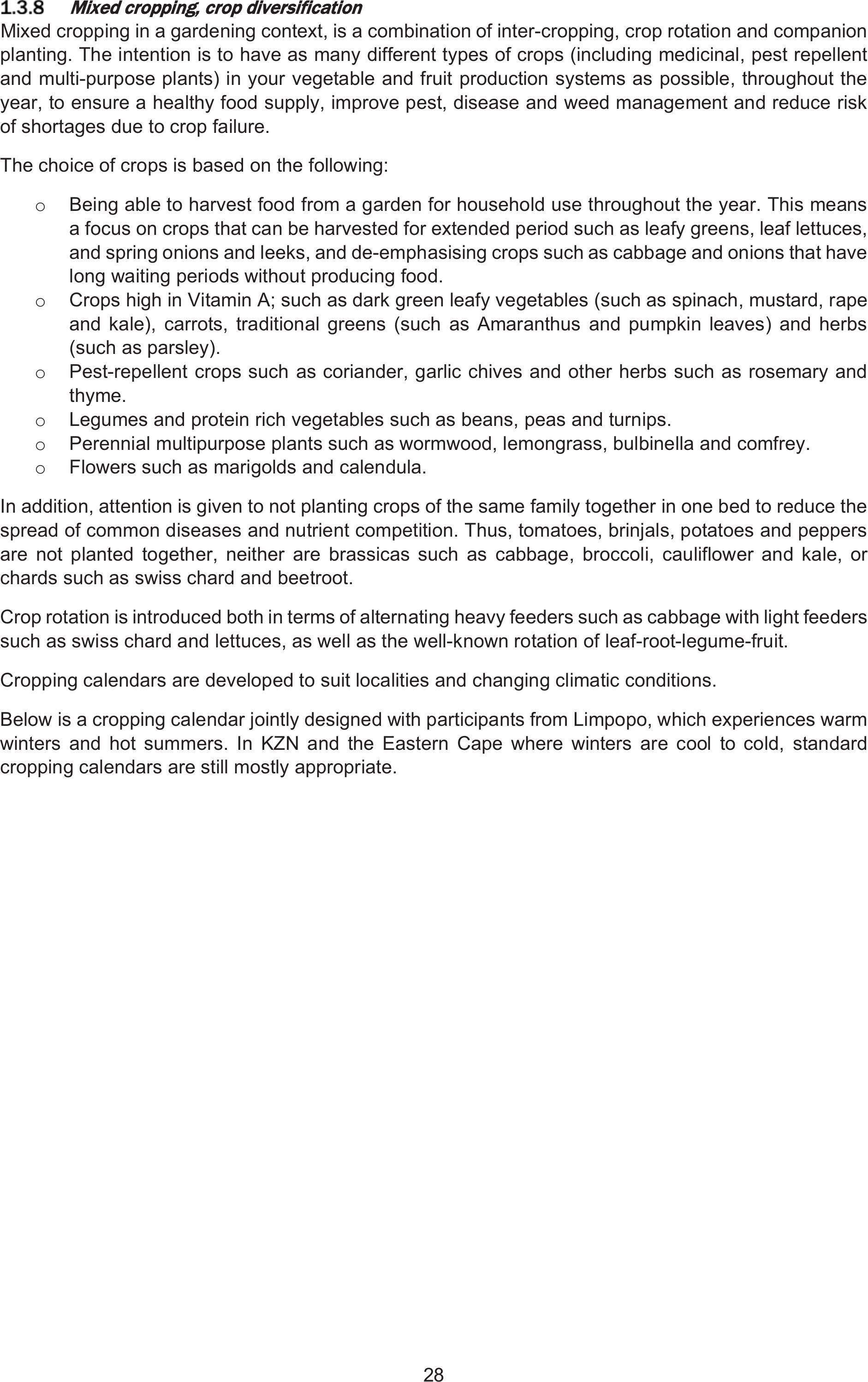
28
M
Mixed cropping, crop diversification
Mixed cropping in a gardening context, is a combination of inter-cropping, crop rotation and companion
planting. The intention is to have as many different types of crops (including medicinal, pest repellent
and multi-purpose plants) in your vegetable and fruit production systems as possible, throughout the
year, to ensure a healthy food supply, improve pest, disease and weed management and reduce risk
of shortages due to crop failure.
The choice of crops is based on the following:
oBeing able to harvest food from a garden for household use throughout the year. This means
a focus on crops that can be harvested for extended period such as leafy greens, leaf lettuces,
and spring onions and leeks, and de-emphasising crops such as cabbage and onions that have
long waiting periods without producing food.
oCrops high in Vitamin A; such as dark green leafy vegetables (such as spinach, mustard, rape
and kale), carrots, traditional greens (such as Amaranthus and pumpkin leaves) and herbs
(such as parsley).
oPest-repellent crops such as coriander, garlic chives and other herbs such as rosemary and
thyme.
oLegumes and protein rich vegetables such as beans, peas and turnips.
oPerennial multipurpose plants such as wormwood, lemongrass, bulbinella and comfrey.
oFlowers such as marigolds and calendula.
In addition, attention is given to not planting crops of the same family together in one bed to reduce the
spread of common diseases and nutrient competition. Thus, tomatoes, brinjals, potatoes and peppers
are not planted together, neither are brassicas such as cabbage, broccoli, cauliflower and kale, or
chards such as swiss chard and beetroot.
Crop rotation is introduced both in terms of alternating heavy feeders such as cabbage with light feeders
such as swiss chard and lettuces, as well as the well-known rotation of leaf-root-legume-fruit.
Cropping calendars are developed to suit localities and changing climatic conditions.
Below is a cropping calendar jointly designed with participants from Limpopo, which experiences warm
winters and hot summers. In KZN and the Eastern Cape where winters are cool to cold, standard
cropping calendars are still mostly appropriate.
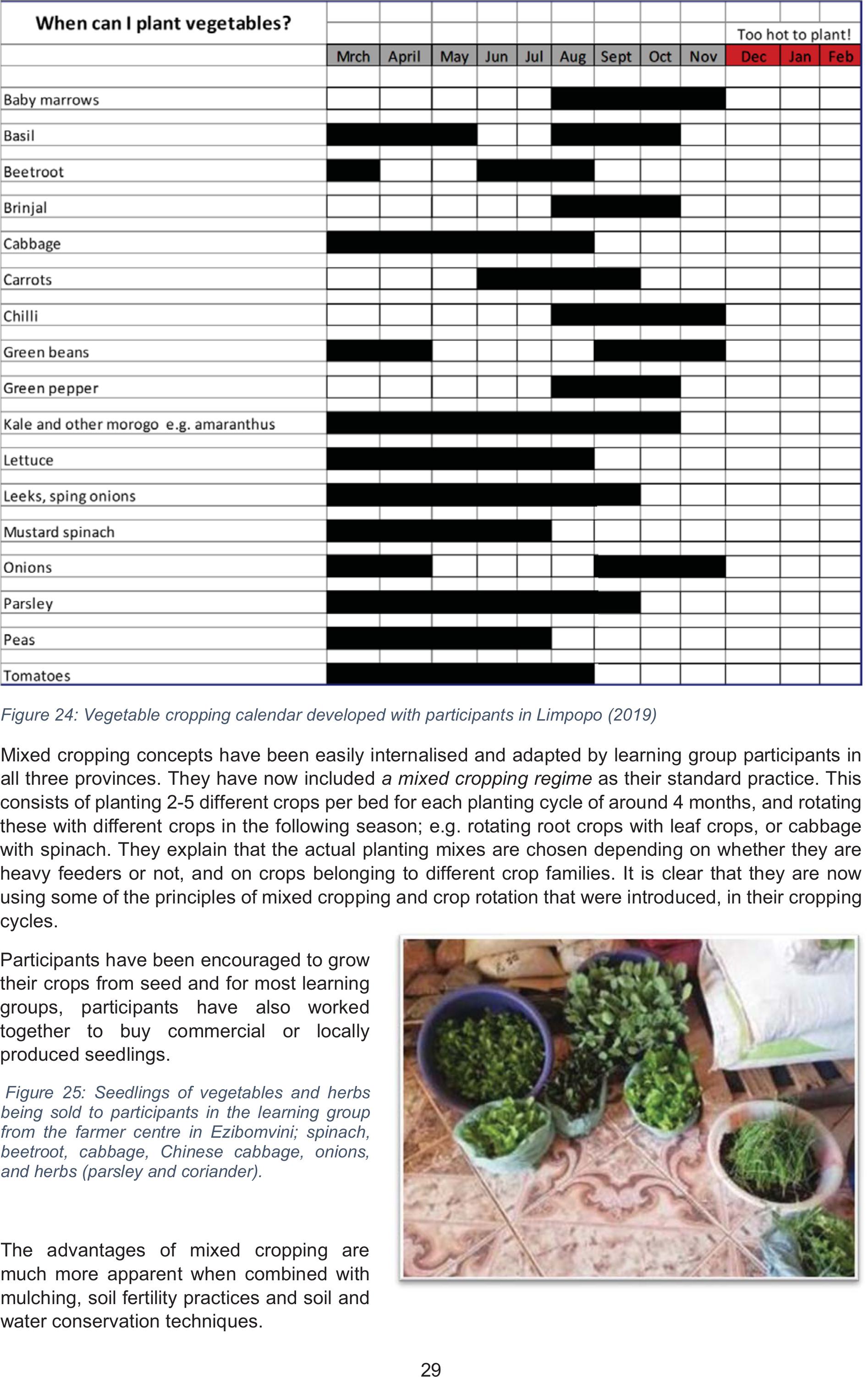
29
Figure 24: Vegetable cropping calendar developed with participants in Limpopo (2019)
Mixed cropping concepts have been easily internalised and adapted by learning group participants in
all three provinces. They have now included a mixed cropping regime as their standard practice. This
consists of planting 2-5 different crops per bed for each planting cycle of around 4 months, and rotating
these with different crops in the following season; e.g. rotating root crops with leaf crops, or cabbage
with spinach. They explain that the actual planting mixes are chosen depending on whether they are
heavy feeders or not, and on crops belonging to different crop families. It is clear that they are now
using some of the principles of mixed cropping and crop rotation that were introduced, in their cropping
cycles.
Participants have been encouraged to grow
their crops from seed and for most learning
groups, participants have also worked
together to buy commercial or locally
produced seedlings.
Figure 25: Seedlings of vegetables and herbs
being sold to participants in the learning group
from the farmer centre in Ezibomvini; spinach,
beetroot, cabbage, Chinese cabbage, onions,
and herbs (parsley and coriander).
The advantages of mixed cropping are
much more apparent when combined with
mulching, soil fertility practices and soil and
water conservation techniques.
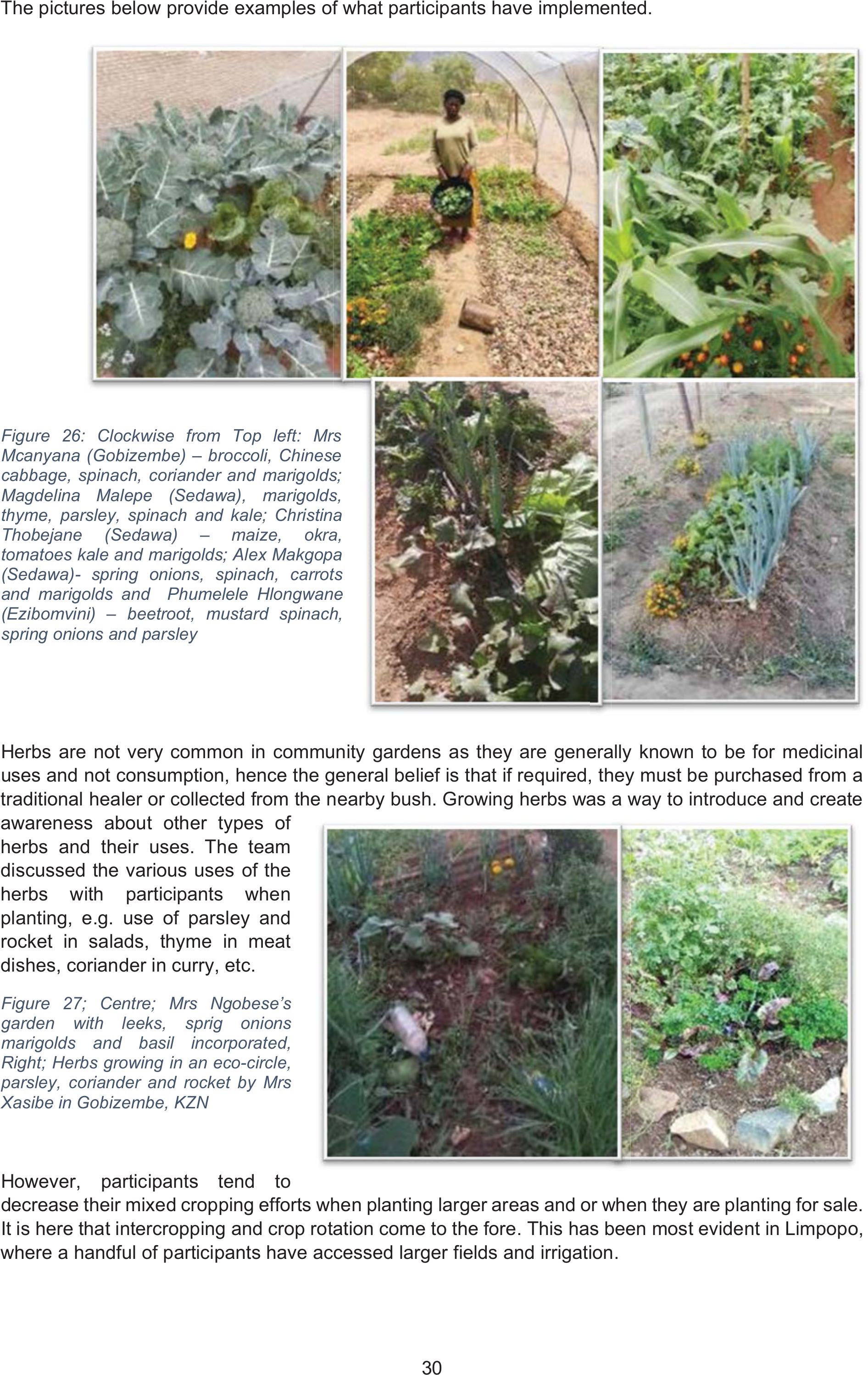
30
The pictures below provide examples of what participants have implemented.
Figure 26: Clockwise from Top left: Mrs
Mcanyana (Gobizembe) – broccoli, Chinese
cabbage, spinach, coriander and marigolds;
Magdelina Malepe (Sedawa), marigolds,
thyme, parsley, spinach and kale; Christina
Thobejane (Sedawa) – maize, okra,
tomatoes kale and marigolds; Alex Makgopa
(Sedawa)- spring onions, spinach, carrots
and marigolds and Phumelele Hlongwane
(Ezibomvini) – beetroot, mustard spinach,
spring onions and parsley
Herbs are not very common in community gardens as they are generally known to be for medicinal
uses and not consumption, hence the general belief is that if required, they must be purchased from a
traditional healer or collected from the nearby bush. Growing herbs was a way to introduce and create
awareness about other types of
herbs and their uses. The team
discussed the various uses of the
herbs with participants when
planting, e.g. use of parsley and
rocket in salads, thyme in meat
dishes, coriander in curry, etc.
Figure 27; Centre; Mrs Ngobese’s
garden with leeks, sprig onions
marigolds and basil incorporated,
Right; Herbs growing in an eco-circle,
parsley, coriander and rocket by Mrs
Xasibe in Gobizembe, KZN
However, participants tend to
decrease their mixed cropping efforts when planting larger areas and or when they are planting for sale.
It is here that intercropping and crop rotation come to the fore. This has been most evident in Limpopo,
where a handful of participants have accessed larger fields and irrigation.
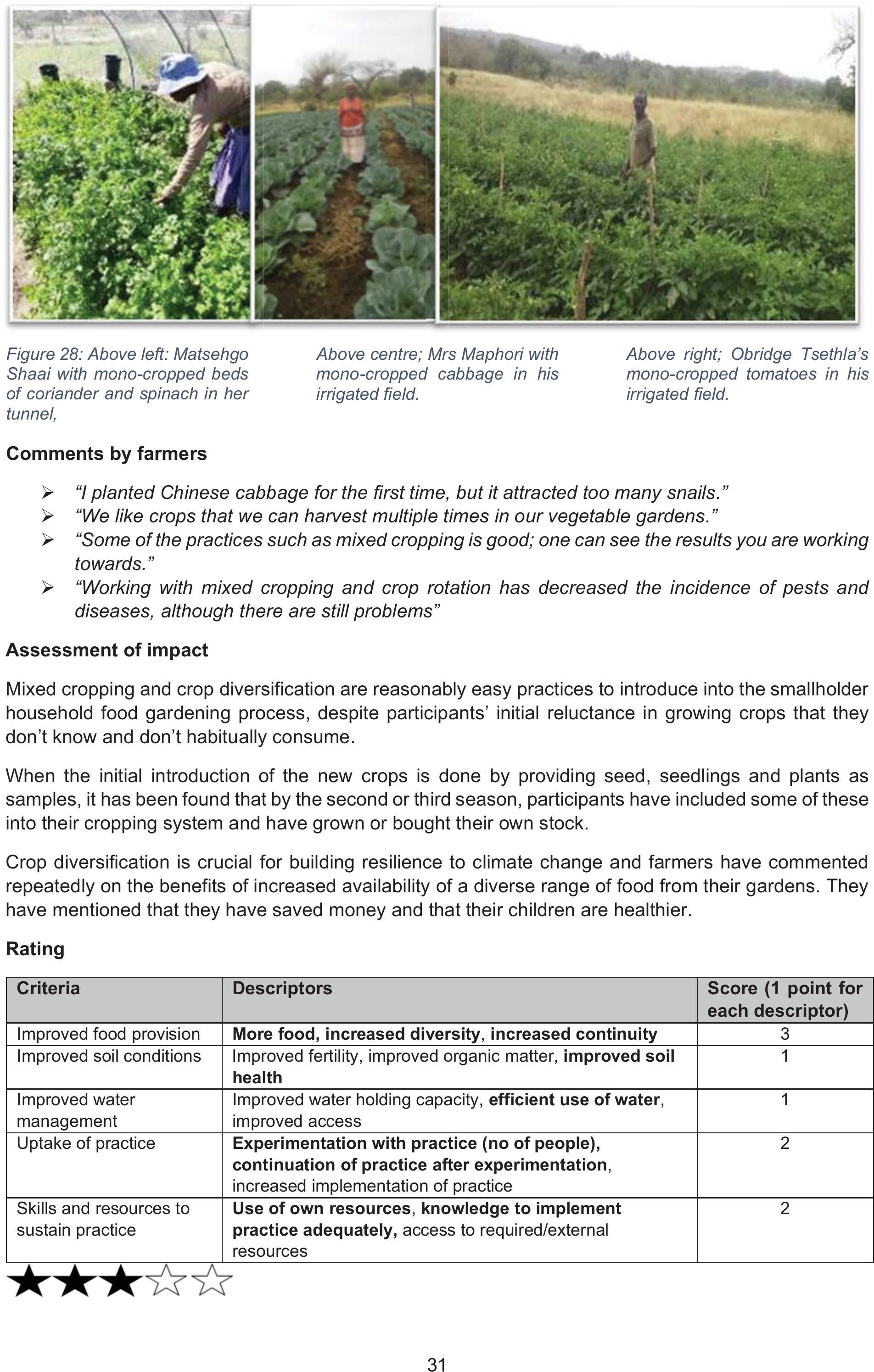
31
Figure 28: Above left: Matsehgo
Shaai with mono-cropped beds
of coriander and spinach in her
tunnel,
Above centre; Mrs Maphori with
mono-cropped cabbage in his
irrigated field.
Above right; Obridge Tsethla’s
mono-cropped tomatoes in his
irrigated field.
Comments by farmers
¾“I planted Chinese cabbage for the first time, but it attracted too many snails.”
¾“We like crops that we can harvest multiple times in our vegetable gardens.”
¾“Some of the practices such as mixed cropping is good; one can see the results you are working
towards.”
¾“Working with mixed cropping and crop rotation has decreased the incidence of pests and
diseases, although there are still problems”
Assessment of impact
Mixed cropping and crop diversification are reasonably easy practices to introduce into the smallholder
household food gardening process, despite participants’ initial reluctance in growing crops that they
don’t know and don’t habitually consume.
When the initial introduction of the new crops is done by providing seed, seedlings and plants as
samples, it has been found that by the second or third season, participants have included some of these
into their cropping system and have grown or bought their own stock.
Crop diversification is crucial for building resilience to climate change and farmers have commented
repeatedly on the benefits of increased availability of a diverse range of food from their gardens. They
have mentioned that they have saved money and that their children are healthier.
Rating
Criteria Descriptors Score (1 point for
each descriptor)
Improved food provision More food, increased diversity, increased continuity 3
Improved soil conditions Improved fertility, improved organic matter, improved soil
health
1
Improved water
management
Improved water holding capacity, efficient use of water,
improved access
1
Uptake of practice Experimentation with practice (no of people),
continuation of practice after experimentation,
increased implementation of practice
2
Skills and resources to
sustain practice
Use of own resources, knowledge to implement
practice adequately, access to required/external
resources
2
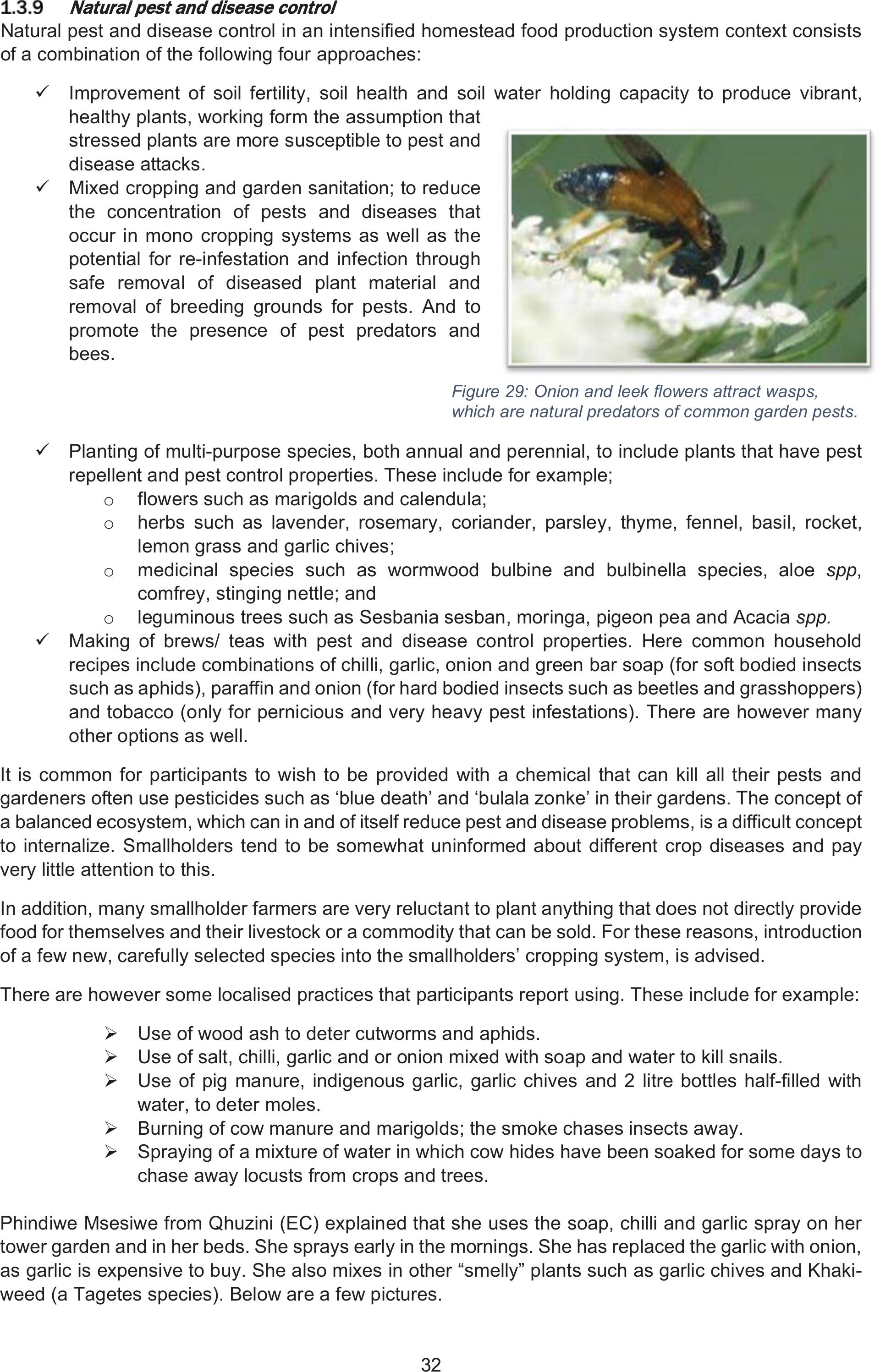
32
N
Natural pest and disease control
Natural pest and disease control in an intensified homestead food production system context consists
of a combination of the following four approaches:
9Improvement of soil fertility, soil health and soil water holding capacity to produce vibrant,
healthy plants, working form the assumption that
stressed plants are more susceptible to pest and
disease attacks.
9Mixed cropping and garden sanitation; to reduce
the concentration of pests and diseases that
occur in mono cropping systems as well as the
potential for re-infestation and infection through
safe removal of diseased plant material and
removal of breeding grounds for pests. And to
promote the presence of pest predators and
bees.
Figure 29: Onion and leek flowers attract wasps,
which are natural predators of common garden pests.
9Planting of multi-purpose species, both annual and perennial, to include plants that have pest
repellent and pest control properties. These include for example;
oflowers such as marigolds and calendula;
oherbs such as lavender, rosemary, coriander, parsley, thyme, fennel, basil, rocket,
lemon grass and garlic chives;
omedicinal species such as wormwood bulbine and bulbinella species, aloe spp,
comfrey, stinging nettle; and
oleguminous trees such as Sesbania sesban, moringa, pigeon pea and Acacia spp.
9Making of brews/ teas with pest and disease control properties. Here common household
recipes include combinations of chilli, garlic, onion and green bar soap (for soft bodied insects
such as aphids), paraffin and onion (for hard bodied insects such as beetles and grasshoppers)
and tobacco (only for pernicious and very heavy pest infestations). There are however many
other options as well.
It is common for participants to wish to be provided with a chemical that can kill all their pests and
gardeners often use pesticides such as ‘blue death’ and ‘bulala zonke’ in their gardens. The concept of
a balanced ecosystem, which can in and of itself reduce pest and disease problems, is a difficult concept
to internalize. Smallholders tend to be somewhat uninformed about different crop diseases and pay
very little attention to this.
In addition, many smallholder farmers are very reluctant to plant anything that does not directly provide
food for themselves and their livestock or a commodity that can be sold. For these reasons, introduction
of a few new, carefully selected species into the smallholders’ cropping system, is advised.
There are however some localised practices that participants report using. These include for example:
¾Use of wood ash to deter cutworms and aphids.
¾Use of salt, chilli, garlic and or onion mixed with soap and water to kill snails.
¾Use of pig manure, indigenous garlic, garlic chives and 2 litre bottles half-filled with
water, to deter moles.
¾Burning of cow manure and marigolds; the smoke chases insects away.
¾Spraying of a mixture of water in which cow hides have been soaked for some days to
chase away locusts from crops and trees.
Phindiwe Msesiwe from Qhuzini (EC) explained that she uses the soap, chilli and garlic spray on her
tower garden and in her beds. She sprays early in the mornings. She has replaced the garlic with onion,
as garlic is expensive to buy. She also mixes in other “smelly” plants such as garlic chives and Khaki-
weed (a Tagetes species). Below are a few pictures.
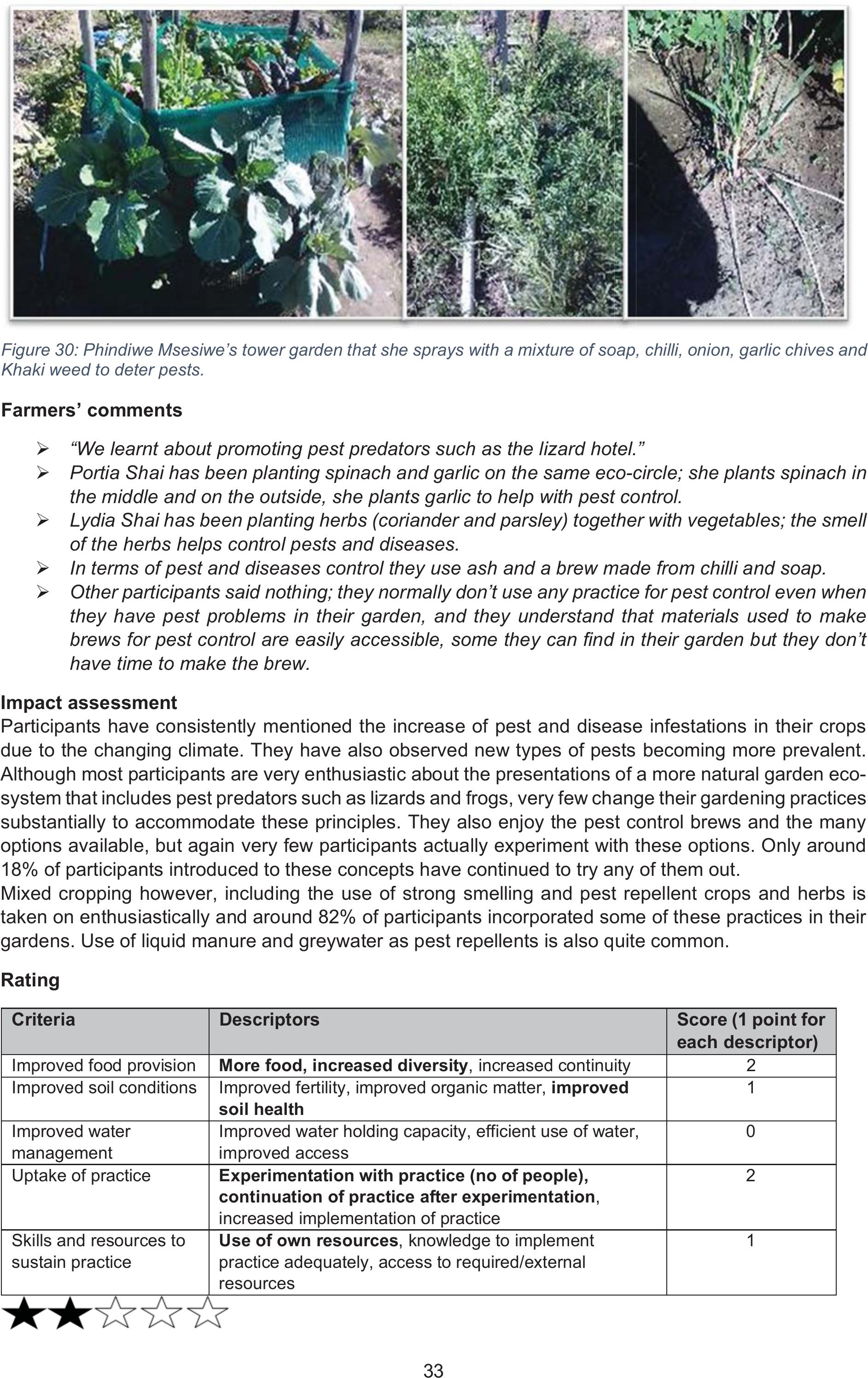
33
Figure 30: Phindiwe Msesiwe’s tower garden that she sprays with a mixture of soap, chilli, onion, garlic chives and
Khaki weed to deter pests.
Farmers’ comments
¾“We learnt about promoting pest predators such as the lizard hotel.”
¾Portia Shai has been planting spinach and garlic on the same eco-circle; she plants spinach in
the middle and on the outside, she plants garlic to help with pest control.
¾Lydia Shai has been planting herbs (coriander and parsley) together with vegetables; the smell
of the herbs helps control pests and diseases.
¾In terms of pest and diseases control they use ash and a brew made from chilli and soap.
¾Other participants said nothing; they normally don’t use any practice for pest control even when
they have pest problems in their garden, and they understand that materials used to make
brews for pest control are easily accessible, some they can find in their garden but they don’t
have time to make the brew.
Impact assessment
Participants have consistently mentioned the increase of pest and disease infestations in their crops
due to the changing climate. They have also observed new types of pests becoming more prevalent.
Although most participants are very enthusiastic about the presentations of a more natural garden eco-
system that includes pest predators such as lizards and frogs, very few change their gardening practices
substantially to accommodate these principles. They also enjoy the pest control brews and the many
options available, but again very few participants actually experiment with these options. Only around
18% of participants introduced to these concepts have continued to try any of them out.
Mixed cropping however, including the use of strong smelling and pest repellent crops and herbs is
taken on enthusiastically and around 82% of participants incorporated some of these practices in their
gardens. Use of liquid manure and greywater as pest repellents is also quite common.
Rating
Criteria Descriptors Score (1 point for
each descriptor)
Improved food provision More food, increased diversity, increased continuity 2
Improved soil conditions Improved fertility, improved organic matter,improved
soil health
1
Improved water
management
Improved water holding capacity, efficient use of water,
improved access
0
Uptake of practice Experimentation with practice (no of people),
continuation of practice after experimentation,
increased implementation of practice
2
Skills and resources to
sustain practice
Use of own resources, knowledge to implement
practice adequately, access to required/external
resources
1
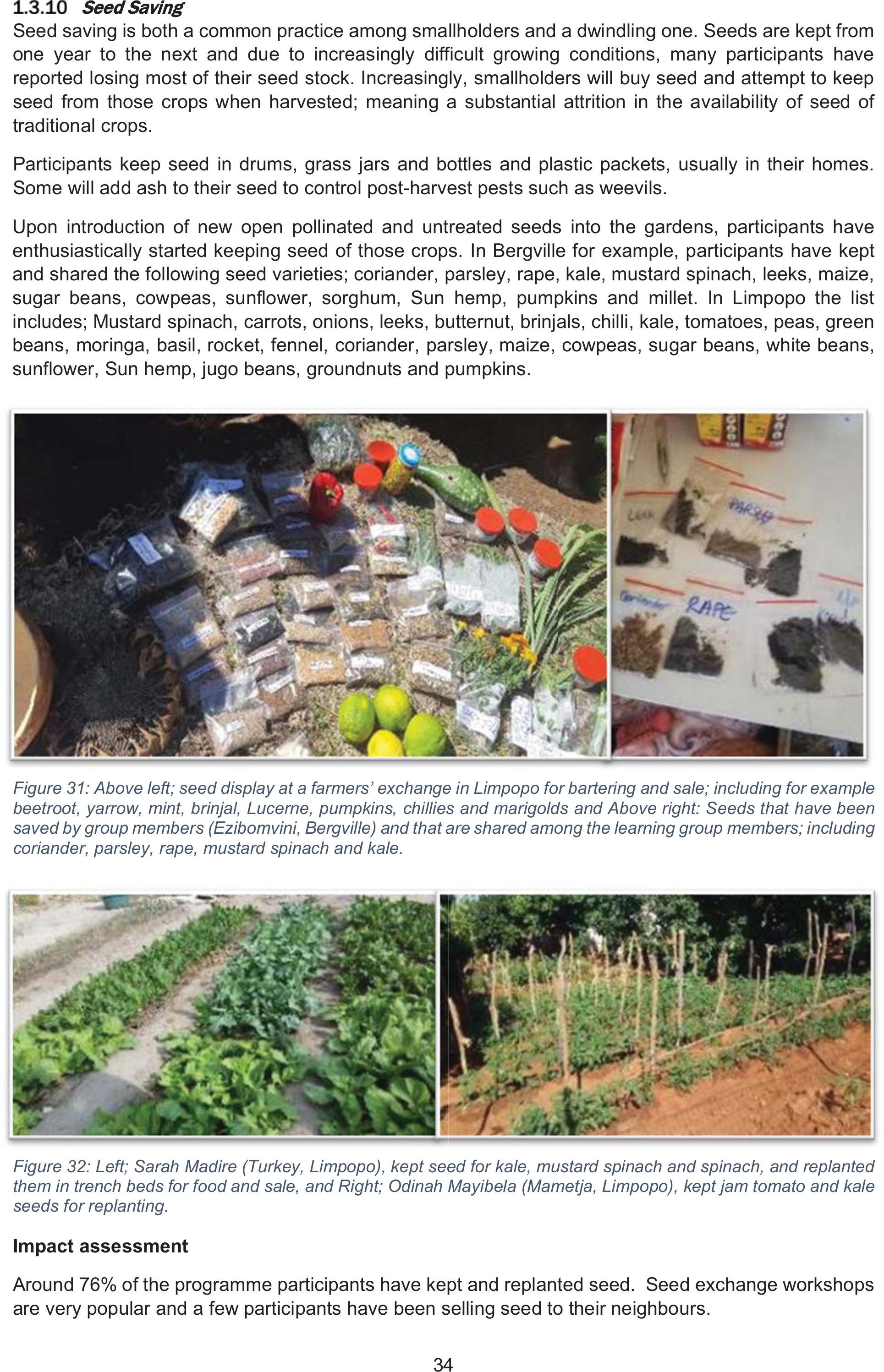
34
S
Seed Saving
Seed saving is both a common practice among smallholders and a dwindling one. Seeds are kept from
one year to the next and due to increasingly difficult growing conditions, many participants have
reported losing most of their seed stock. Increasingly, smallholders will buy seed and attempt to keep
seed from those crops when harvested; meaning a substantial attrition in the availability of seed of
traditional crops.
Participants keep seed in drums, grass jars and bottles and plastic packets, usually in their homes.
Some will add ash to their seed to control post-harvest pests such as weevils.
Upon introduction of new open pollinated and untreated seeds into the gardens, participants have
enthusiastically started keeping seed of those crops. In Bergville for example, participants have kept
and shared the following seed varieties; coriander, parsley, rape, kale, mustard spinach, leeks, maize,
sugar beans, cowpeas, sunflower, sorghum, Sun hemp, pumpkins and millet. In Limpopo the list
includes; Mustard spinach, carrots, onions, leeks, butternut, brinjals, chilli, kale, tomatoes, peas, green
beans, moringa, basil, rocket, fennel, coriander, parsley, maize, cowpeas, sugar beans, white beans,
sunflower, Sun hemp, jugo beans, groundnuts and pumpkins.
Figure 31: Above left; seed display at a farmers’ exchange in Limpopo for bartering and sale; including for example
beetroot, yarrow, mint, brinjal, Lucerne, pumpkins, chillies and marigolds and Above right: Seeds that have been
saved by group members (Ezibomvini, Bergville) and that are shared among the learning group members; including
coriander, parsley, rape, mustard spinach and kale.
Figure 32: Left; Sarah Madire (Turkey, Limpopo), kept seed for kale, mustard spinach and spinach, and replanted
them in trench beds for food and sale, and Right; Odinah Mayibela (Mametja, Limpopo), kept jam tomato and kale
seeds for replanting.
Impact assessment
Around 76% of the programme participants have kept and replanted seed. Seed exchange workshops
are very popular and a few participants have been selling seed to their neighbours.
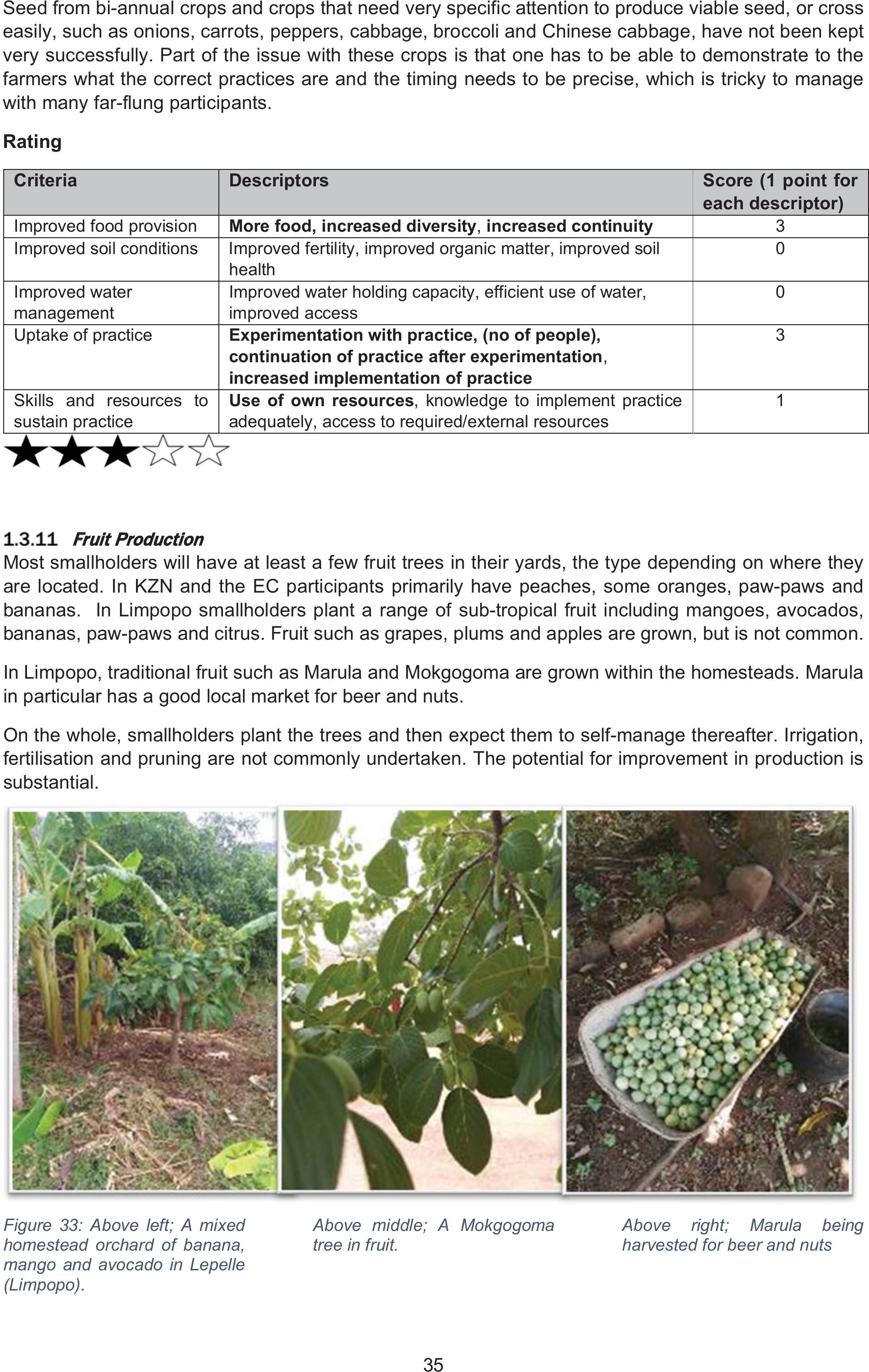
35
Seed from bi-annual crops and crops that need very specific attention to produce viable seed, or cross
easily, such as onions, carrots, peppers, cabbage, broccoli and Chinese cabbage, have not been kept
very successfully. Part of the issue with these crops is that one has to be able to demonstrate to the
farmers what the correct practices are and the timing needs to be precise, which is tricky to manage
with many far-flung participants.
Rating
Criteria Descriptors Score (1 point for
each descriptor)
Improved food provision More food, increased diversity, increased continuity 3
Improved soil conditions Improved fertility, improved organic matter, improved soil
health
0
Improved water
management
Improved water holding capacity, efficient use of water,
improved access
0
Uptake of practice Experimentation with practice, (no of people),
continuation of practice after experimentation,
increased implementation of practice
3
Skills and resources to
sustain practice
Use of own resources, knowledge to implement practice
adequately, access to required/external resources
1
F
Fruit Production
Most smallholders will have at least a few fruit trees in their yards, the type depending on where they
are located. In KZN and the EC participants primarily have peaches, some oranges, paw-paws and
bananas. In Limpopo smallholders plant a range of sub-tropical fruit including mangoes, avocados,
bananas, paw-paws and citrus. Fruit such as grapes, plums and apples are grown, but is not common.
In Limpopo, traditional fruit such as Marula and Mokgogoma are grown within the homesteads. Marula
in particular has a good local market for beer and nuts.
On the whole, smallholders plant the trees and then expect them to self-manage thereafter. Irrigation,
fertilisation and pruning are not commonly undertaken. The potential for improvement in production is
substantial.
Figure 33: Above left; A mixed
homestead orchard of banana,
mango and avocado in Lepelle
(Limpopo).
Above middle; A Mokgogoma
tree in fruit.
Above right; Marula being
harvested for beer and nuts
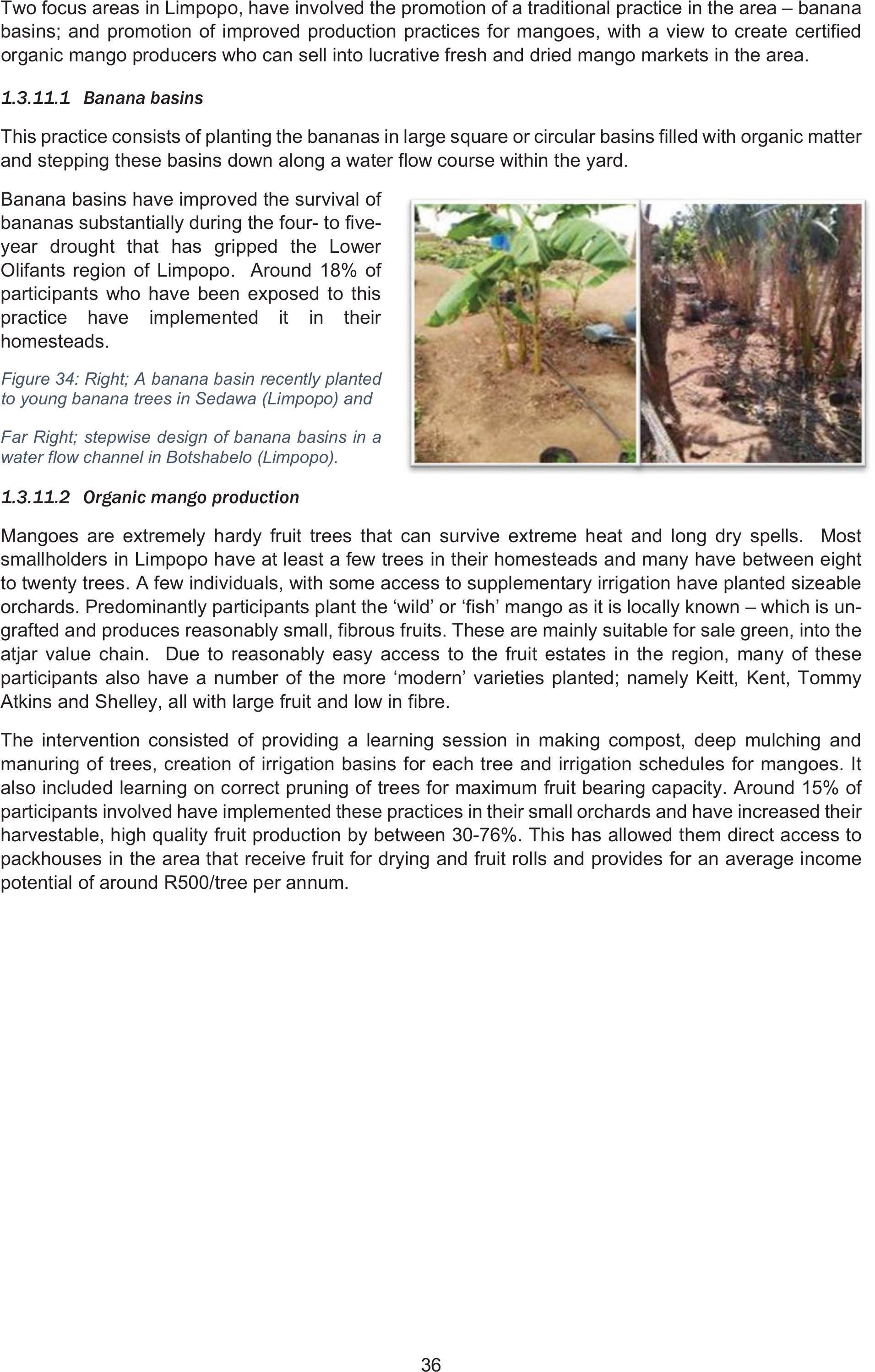
36
Two focus areas in Limpopo, have involved the promotion of a traditional practice in the area – banana
basins; and promotion of improved production practices for mangoes, with a view to create certified
organic mango producers who can sell into lucrative fresh and dried mango markets in the area.
1.3.11.1Banana basins
This practice consists of planting the bananas in large square or circular basins filled with organic matter
and stepping these basins down along a water flow course within the yard.
Banana basins have improved the survival of
bananas substantially during the four- to five-
year drought that has gripped the Lower
Olifants region of Limpopo. Around 18% of
participants who have been exposed to this
practice have implemented it in their
homesteads.
Figure 34: Right; A banana basin recently planted
to young banana trees in Sedawa (Limpopo) and
Far Right; stepwise design of banana basins in a
water flow channel in Botshabelo (Limpopo).
1.3.11.2Organic mango production
Mangoes are extremely hardy fruit trees that can survive extreme heat and long dry spells. Most
smallholders in Limpopo have at least a few trees in their homesteads and many have between eight
to twenty trees. A few individuals, with some access to supplementary irrigation have planted sizeable
orchards. Predominantly participants plant the ‘wild’ or ‘fish’ mango as it is locally known – which is un-
grafted and produces reasonably small, fibrous fruits. These are mainly suitable for sale green, into the
atjar value chain. Due to reasonably easy access to the fruit estates in the region, many of these
participants also have a number of the more ‘modern’ varieties planted; namely Keitt, Kent, Tommy
Atkins and Shelley, all with large fruit and low in fibre.
The intervention consisted of providing a learning session in making compost, deep mulching and
manuring of trees, creation of irrigation basins for each tree and irrigation schedules for mangoes. It
also included learning on correct pruning of trees for maximum fruit bearing capacity. Around 15% of
participants involved have implemented these practices in their small orchards and have increased their
harvestable, high quality fruit production by between 30-76%. This has allowed them direct access to
packhouses in the area that receive fruit for drying and fruit rolls and provides for an average income
potential of around R500/tree per annum.

37
Figure 35: Above
Left; A pruned mango
tree pushing out new
growth, with compost
added in the irrigation
basin and mulching
(Matshego Shaai).
.Above centre left;
Pruning, composting
and irrigation basins
added for an old
mango tree to bring it
back into production
(Mpelesi Sekgobela),
Above centre right;
Shakes Searane’s
mango orchard in
Lepelle, being
inspected by a mango
estate manager.
Above right; Mango
juice produced by
Christina Thobejane
(Sedawa).
Comments from farmers
¾“I already knew how to prune the mango trees, but these new practices have reduced the pest
and disease problems in our trees and with continued practice I think I will make a lot more
money than the R6 000 I made this year (from 15 trees) (Matshego Shaai, Turkey).”
¾“I have realized that it is important to irrigate the trees, as the ones I did not water have died
back in this drought. Also, if you water the trees, then the small fruit don’t drop off due to stress
(Norah Tsetlha, Sedawa).”
¾“We always believed that there was nothing we could do to improve the yields of our mangoes
and wondered why the trees in the commercial estates look so good. Now we can produce
beautiful mangoes, just like them (Christina Thobejane).”
Rating
Criteria Descriptors Score (1 point for
each descriptor)
Improved food provision More food, increased diversity, increased continuity 2
Improved soil conditions Improved fertility, improved organic matter, improved
soil health
3
Improved water
management
Improved water holding capacity, efficient use of water,
improved access
2
Uptake of practice Experimentation with practice (no of people),
continuation of practice after experimentation,
increased implementation of practice
2
Skills and resources to
sustain practice
Use of own resources, knowledge to implement
practice adequately, access to required/external
resources
2

38
S
Stone bunds and check dams
Stone lines or bunds are a soil and water conservation practice that is appropriate for large sloped,
eroded areas. The stones are keyed into the slope, along contours, to reduce erosion caused by
overland flow of water. Often small gullies/dongas start forming on such denuded areas in the natural
water flow channels and then check dams are constructed either separately or into the lines of stones.
The intention is to slow the flow of water, so that the silt and soil load can be dropped. The outcome is
the formation of small benched terraces of fertile soil for plant growth.
This practice has been the most appropriate for Limpopo, where in the Lower Olifants’ region there are
large tracts of denuded soil in and around the homesteads, easily erodible top soil and long periods of
heat and drought followed by intense rainfall events. Coupled to the local practice of clearing homestead
plots completely and sweeping or raking the dirt to keep the yards clean, many homesteads have a
high level of erosion. Stone bunds/ lines are a traditional practice in the area that was further promoted
and also slightly improved upon in terms of placing the stone lines along contours and keying them into
the soil to ensure greater stability. Around 61% of participants exposed to this ‘improved’ practice
implemented stone lines in and around their yards.
Below are some examples.
Figure 36:
Left; Sand
bags used,
where
stones were
not available
to reduce
overland
flow and
erosion
caused by
water
running
along a road
in Willows
(Limpopo),
Centre:
Small stone
lines along a fence line in the Oaks (Limpopo) and Right; A large stone bund also acts as a water holding
structure for a line of bananas planted directly below the line in Lepelle (Limpopo).
Figure 37: Above left;
a close-up of a keyed
in stone line,
Above centre left; a
group of participants
constructing a stone
line.
Above centre right;
the resultant stone
line structure upon
completion
Above right;
revegetation of the
denuded slope
around four to five
months later
(Lepelle, Limpopo).

39
Figure 38: Right:
Two small stone
lines with young
pigeon pea trees
planted above the
lines in a
homestead and
Far Right;
constructing a
check dam to
reduce gulley
erosion in a
participant’s
garden (Turkey,
Limpopo).
Rating
Criteria Descriptors Score (1 point for
each descriptor)
Improved food provision More food, increased diversity, increased continuity1
Improved soil conditions Improved fertility, improved organic matter, improved
soil health
2
Improved water
management
Improved water holding capacity, efficient use of water,
improved access
1
Uptake of practice Experimentation with practice (no of people),
continuation of practice after experimentation,
increased implementation of practice
2
Skills and resources to
sustain practice
Use of own resources, knowledge to implement
practice adequately, access to required/external
resources
2
I
Infiltration ditches (run-on ditches, diversion ditches)
These are shallow ditches (30 cm wide and 15-30 cm deep) that are dug either to channel water to a
specific area (diversion ditches) or to catch water and allow it to sink into the soil in a cropping area
(run-on ditches); the latter are dug along contours.
These ditches increase access to and availability of water in intensive food production.
Below are a few examples.
Figure 39: Left; A
diversion ditch
leading water from
the road and fence
line into a
homestead garden
(Botshabelo),
Centre; a cut-off
drain or run-on ditch
intercepting water
flowing from a
house down into the
garden (Sedawa)
and Right; a
diversion ditch
leading to an
infiltration pit into
which crops will be
planted, dug as a
demonstration at Aviwe Biko’s homestead Dimbaza, EC).

40
Figure 40: Above Left: A run-on
ditch with sweet potatoes
planted on the ridge below the
ditch (The Oaks),
Above centre; A diversion ditch
channelling water from the
fence line and road to trench
beds and banana basins in the
garden (The Oaks).
Above right: A group of
participants digging another
diversion ditch in a homestead
garden (Willows).
Farmers’ comments
¾“Here in Gobizembe (SKZN), some of us have adapted the diversion ditches to direct greywater
to our gardens. Infiltration ditches do help over time to improve the condition of the soil; as
organic matter collects in these ditches and use of greywater in these ditches improves yields
substantially.”
Impact assessment
It can be tricky to decide where to place diversion ditches and run-on ditches in a landscape, as it
requires a practiced eye in terms of water flow patterns. Participants who have been assisted to place
and construct these ditches generally make good use of them, but very few participants undertake to
dig these ditches for themselves. Only around 5 to 7% of participants have undertaken this practice.
These ditches can have a significant impact on reducing localised soil erosion due to water flow and in
increasing available water in the soil for crop production.
Rating
Criteria Descriptors Score (1 point for
each descriptor)
Improved food provision More food, increased diversity, increased continuity1
Improved soil conditionsImproved fertility, improved organic matter, improved soil
health
Improved water
management
Improved water holding capacity, efficient use of water,
improved access
3
Uptake of practice Experimentation with practice (no of people), continuation
of practice after experimentation, increased
implementation of practice
1
Skills and resources to
sustain practice
Use of own resources, knowledge to implement practice
adequately, access to required/external resources
1

41
R
Rainwater harvesting (RWH); from roofs and yards
Rainwater harvesting is a common practice undertaken in all three provinces (Limpopo, KZN and EC),
although it is more prevalent in the water stressed communities in Limpopo, where 100% of participants
avow to using the practice. It consists mainly of using basins and drums to catch water off roofs and
structures.
The number of households who have large tanks; such as 2200 litre and 5000 litre Jo-Jo tanks is much
lower, about 5% of all participants.
Figure 41: Above Left and Centre; examples of drums and basins used for RWH collection and Right; a 2200 litre
JoJo tank for roof rainwater harvesting (Limpopo).
Underground RWH tanks can take advantage of both rainwater off roofs as well as overland flow from
hard surfaces around homesteads. In these cases, large underground structures between 25 and
40 m3 have been constructed. The resource and technical requirements for these structures are high
and mostly they cannot be undertaken without dedicated funding and support.
Figure 42: Right; an underground
RWH tank (24 m3) made from
ferrocement, with a brick wall to
support the roof (Sedawa) and Far
Right; a similar underground tank
constructed using bidim cloth and
sealant (Botshabelo). Below; another
example of an underground tank
(18 m3), with a removable metal roof
(Acornhoek).
Impact assessment
For the most part, the enormous potential for RWH is not realised, for both roof RWH and underground
tanks. Both funding and technical expertise is required.
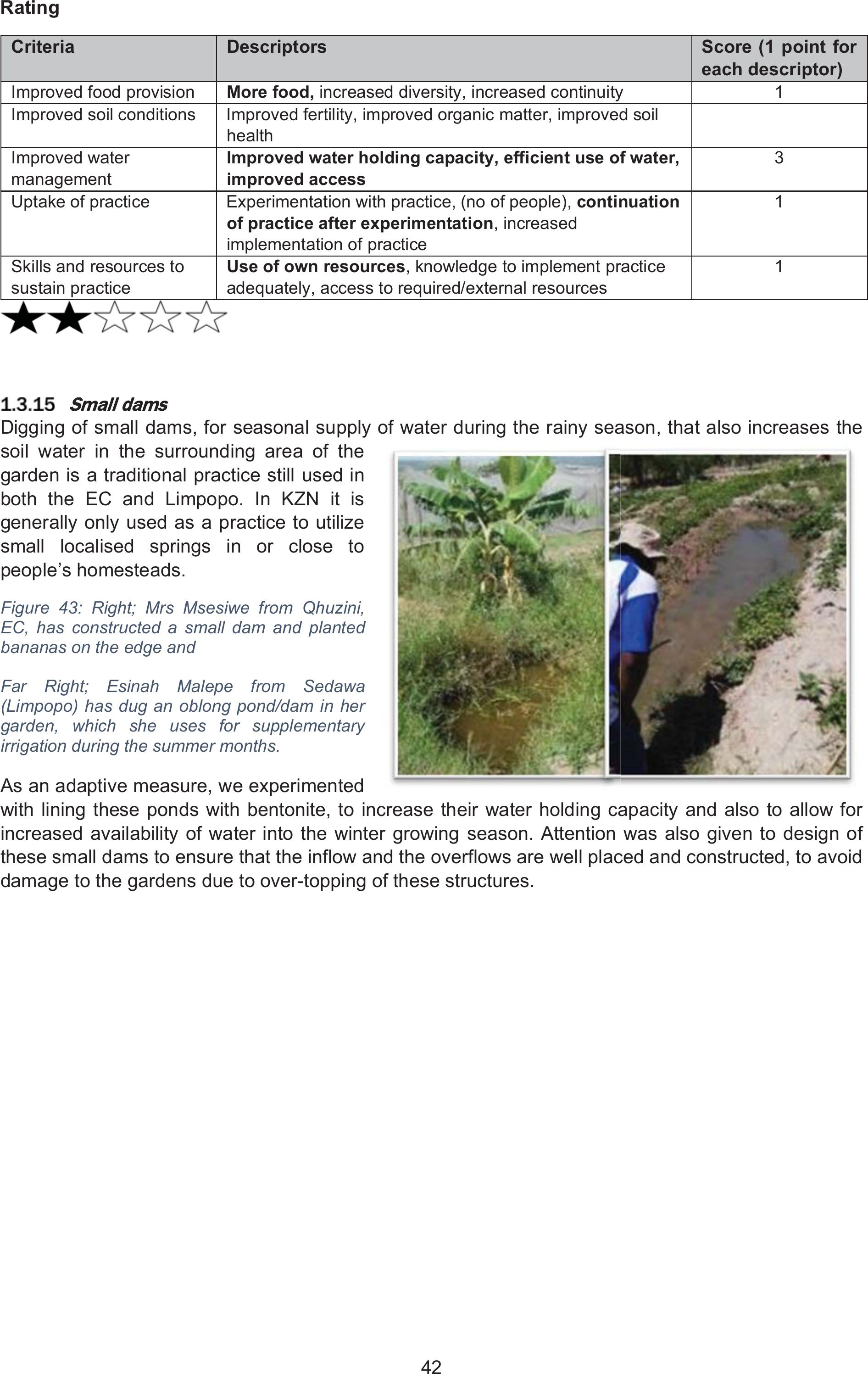
42
Rating
Criteria Descriptors Score (1 point for
each descriptor)
Improved food provision More food, increased diversity, increased continuity1
Improved soil conditions Improved fertility,improved organic matter, improved soil
health
Improved water
management
Improved water holding capacity, efficient use of water,
improved access
3
Uptake of practice Experimentation with practice, (no of people), continuation
of practice after experimentation, increased
implementation of practice
1
Skills and resources to
sustain practice
Use of own resources, knowledge to implement practice
adequately, access to required/external resources
1
S
Small dams
Digging of small dams, for seasonal supply of water during the rainy season, that also increases the
soil water in the surrounding area of the
garden is a traditional practice still used in
both the EC and Limpopo. In KZN it is
generally only used as a practice to utilize
small localised springs in or close to
people’s homesteads.
Figure 43: Right; Mrs Msesiwe from Qhuzini,
EC, has constructed a small dam and planted
bananas on the edge and
Far Right; Esinah Malepe from Sedawa
(Limpopo) has dug an oblong pond/dam in her
garden, which she uses for supplementary
irrigation during the summer months.
As an adaptive measure, we experimented
with lining these ponds with bentonite, to increase their water holding capacity and also to allow for
increased availability of water into the winter growing season. Attention was also given to design of
these small dams to ensure that the inflow and the overflows are well placed and constructed, to avoid
damage to the gardens due to over-topping of these structures.
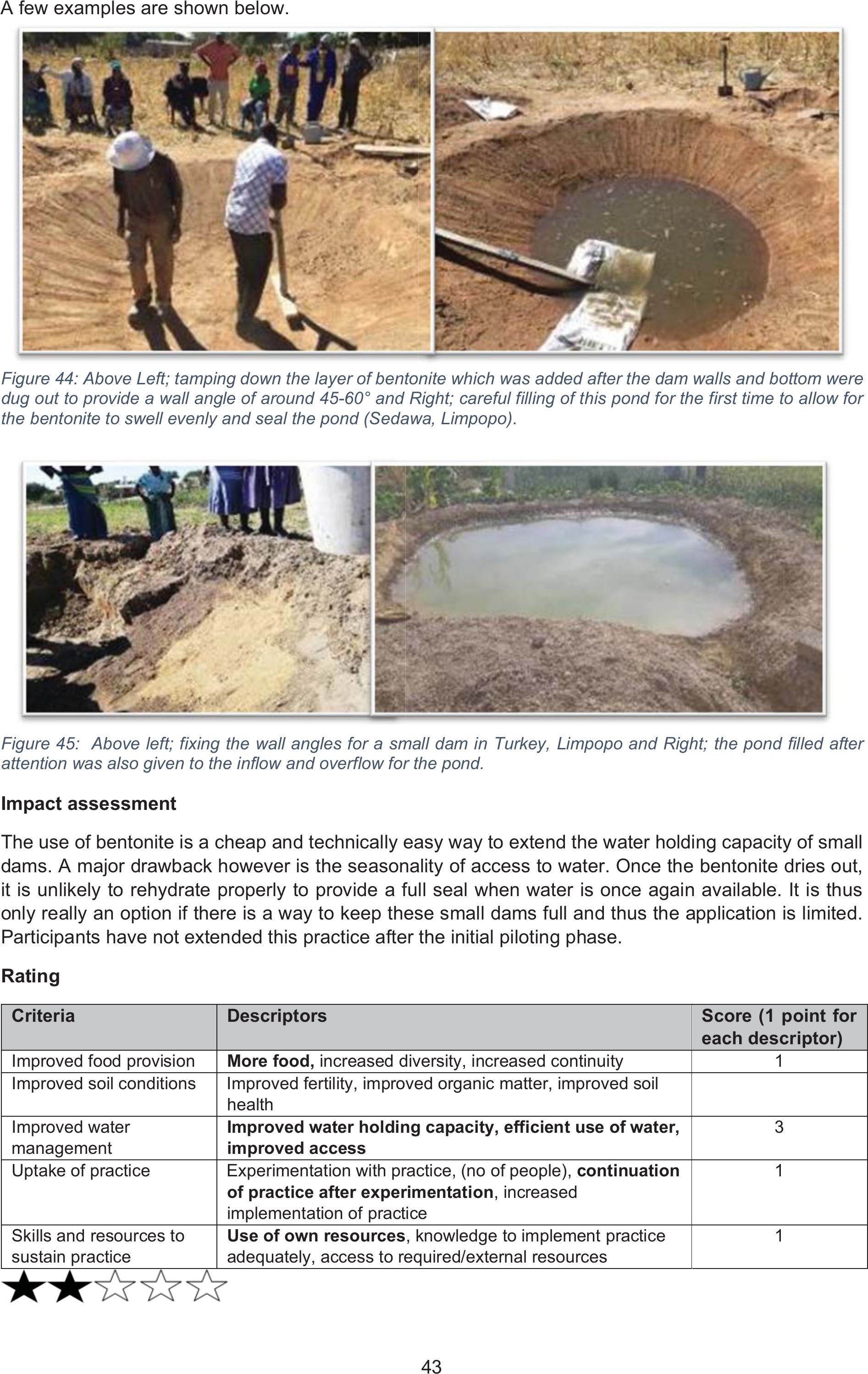
43
A few examples are shown below.
Figure 44: Above Left; tamping down the layer of bentonite which was added after the dam walls and bottom were
dug out to provide a wall angle of around 45-60° and Right; careful filling of this pond for the first time to allow for
the bentonite to swell evenly and seal the pond (Sedawa, Limpopo).
Figure 45: Above left; fixing the wall angles for a small dam in Turkey, Limpopo and Right; the pond filled after
attention was also given to the inflow and overflow for the pond.
Impact assessment
The use of bentonite is a cheap and technically easy way to extend the water holding capacity of small
dams. A major drawback however is the seasonality of access to water. Once the bentonite dries out,
it is unlikely to rehydrate properly to provide a full seal when water is once again available. It is thus
only really an option if there is a way to keep these small dams full and thus the application is limited.
Participants have not extended this practice after the initial piloting phase.
Rating
Criteria Descriptors Score (1 point for
each descriptor)
Improved food provision More food, increased diversity, increased continuity1
Improved soil conditions Improved fertility,improved organic matter, improved soil
health
Improved water
management
Improved water holding capacity, efficient use of water,
improved access
3
Uptake of practice Experimentation with practice, (no of people), continuation
of practice after experimentation, increased
implementation of practice
1
Skills and resources to
sustain practice
Use of own resources, knowledge to implement practice
adequately, access to required/external resources
1
